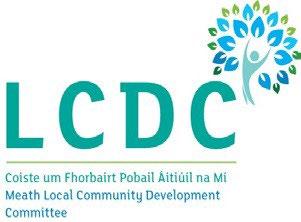























As Chairperson of the Meath Local Community Development Committee, I am delighted to be involved with the preparation of the Local Economic and Community Plan (LECP), the second for County Meath.
It is recognised that our physical, social, and cultural environment impacts hugely on our health and wellbeing. The available data from the most recent census sets out that the population of Meath has grown by 12.9%, the second largest increase in the country and the seasonally adjusted unemployment rate was at a record low of 3.8 per cent in May 2023. The population increase together with an ageing population will bring opportunities as well as challenges.
The Meath LECP sets out an ambitious two-year implementation plan which will help improve all aspects of the county we live in, building on opportunities but also helping to overcome some of the challenges.
The Meath LECP sets out the seven high level goals which were developed following extensive public consultation. Under each of the goals there are Sustainable Community Objectives (SCO’s) and Sustainable Economic Development Objectives (SEDO’s which are complimentary to each other.
The delivery of this LECP will require leadership from the various agencies and I look forward to working with these agencies, many of whom are represented by my colleagues on the Local Community Development Committee. The LCDC members are committed to empowering and participating in the continued development of their communities throughout the county.
I would like to thank Maria Hall of Hub Planning who has assisted in the planning and development of the Meath LECP and Fiona Fallon, Chief Officer who has co-ordinated the delivery of this second Meath LECP and ensured all deadlines were met.
Finally, I would also like to thank everyone who has contributed to the development of the Meath LECP, it is a plan for the improvement of the county and I look forward
to seeing the benefits of its implementation.
Chairperson
SuzanneBrady
Meath Local Economic and Community Plan (LECP), sets out, for a six-year period, the objectives and actions needed to promote and support the economic development and the Community development for the county. Local Economic and Community Plans (LECP's) are the main tool for delivering actions from national and regional strategies at local level. The LECP is desi gned to centralise actions and initiatives related to economic and community development in Meath into a single unified strategy.
Over the lifetime of the County’s first LECP (2016-2021), substantial progress was made towards implementing the plan's High-Level Goals, through a coordinated effort between Meath County Council and other local agencies and organisations. The High-Level Goals that form part of the Meath LECP 2023-2029 will build on the foundation of the first LECP (20162021) and includes new elements which will support the vision set out in the Meath County Development Plan: “To improve the quality of life of all citizens in Meath by creating an environment that supports a vibrant growing economy and a well- connected place to live, learn and do business.
This document, called the Framework LECP, is intended to provide the rationale and evidence-base for the LECP implementation plan. This document will:
• Explain the purpose of an LECP and who will deliver the actions
• Describe how the LECP was developed and prepared
• Provide a snapshot of economic and community statistics in Meath
• Outline key findings from public consultation
• Provide a SWOT analysis informed by findings from research and public consultation
• Present the seven High-Level Goals that will guide the LECP over the next six years
• Provide a detailed outline of the objectives and actions under each High-Level Goal
• Explain how the LECP will be monitored and reviewed on an ongoing basis.
Meath
• Informed by the knowledge and input of community members and stakeholders across Meath
• Outcomes-led: the High-Level Goals provide direction for the objectives and actions in the LECP
• Ambitious, achievable, and realistic












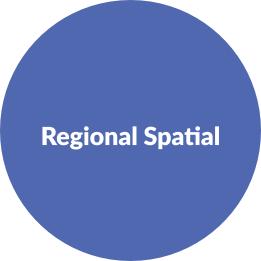






The County Meath LECP is a multiagency plan, which means that actions will be delivered by a wide range of service providers. Service providers include
Meath County Council, both by itself and in partnership with other economic and community development stakeholders. In line with the Public Sector Equality and Human Rights Duty, Meath County Council is committed to promoting equality, preventing discrimination, and protecting the human rights of employees, customers, service users and everyone affected by their policies and plans.
The LECP 2023-2029 is the primary mechanism for delivering national and regional goals at the local level. The figure above shows how the LECP fits into the policy context of Meath (see Appendix A for a list of relevant related policy documents).
The figure below illustrates how national plans and strategies are acknowledged and articulated at the regional and local levels. The LECP is informed by the goals, objectives and best practices outlined in these and other plans and strategies (see Appendix A for a complete list of related policy documents).
An important element of the 20232029 LECP is an increased focus on sustainability Look for the UN Sustainable Development Goals (SDGs) icon in the introduction to each of the sections in Chapter 7.0 to see how Meath’s LECP aligns with the 17 SDGs.
2: Selected national, regional and local plans and strategies informing the Meath LECP







National Plan Economic Enterprise Renewe 2025 Development









National 2018-2027 Plan Development Rura 2021-2025 Policy Our Future Infrastructure Transport Ireland




Connecting


Mobility Plan Ireland







Housing for Housing Plan all: A for Ireland











National Positive Strategy Ageing (NPAS Strategy and Sláintecare Action Plan 2021-2023

Meath Economic Development Strategy

Transport Strategy for the town of Drogheda and Vicinity

Meath Age Friendly Strategy 2023-2028

Regional Enterprise Plan to 2024-MidEast

Meath Traveller Accommodation Programme 2019-2024

Louth Meath CHO Healthy Ireland Plan 2018-2022


Healthy Framework Ireland 2019-2025



Regional Spatial and Economic Strategy (RSES) for EMRA


Healthy Meath Plan 2019-2021


National Action Plan Climate 2023 Biodiversity
National Action Plan 2023









National Integration Migrant Strategy




The Programme Ireland 2023-2027 Strategy for 20Irish 2010-2030 Language


Meath County Development Plan 2019-2025
Transport Strategy for the Greater Dublin Area 2022-2042
Meath Climate Action Stratgey 2019-2024 County Meath Biodiversity Action Plan 2015-2020

Meath CultureCountyand Creativity Strategy


Louth & Meath Integrated Migrant Strategy 2019-2022

Meath County Council Irish Language Scheme 2021-2024

In line with the Local Economic and Community Plan Guidelines issued in 2021, the Meath LECP is comprised of two separate but related components:
• The Framework LECP: includes an evidence-base that is translated into High-Level Goals and objectives that wi ll guide the LECP for the duration of the plan (2023-2029)
• The Implementation Plan: detail the actions to be implemented over the course of two years that will contribute to the achievement of the objectives and High-Level Goals outlined in the Framework LECP.
This structure aims to ensure that the LECP Framework will provide a strong strategic direction. This in turn will allow the Implementation Plan to be flexible and adapted to suit emerging needs throughout the lifetime of the plan, guided by the vision, goals and remit provided by the LECP Framework.
The LECP plans for both the economic and the community development of Meath. These two components are interrelated, or dependent on each other, so there will be some overlap between them in the High-Level Goals, objectives, and actions.


Community Objectives


Economic Development Objectives


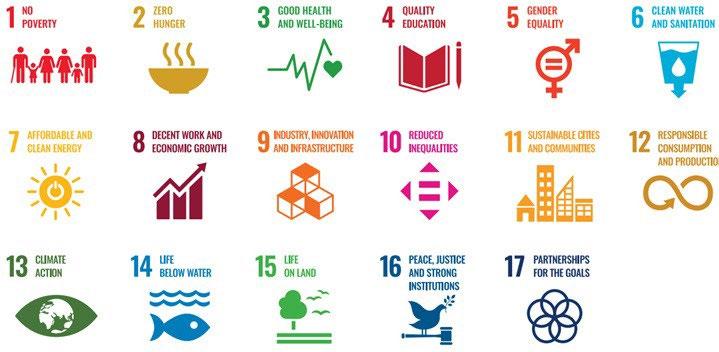
The overall direction of the LECP is guided by High-Level Goals. These main goals provide the core aims of the LECP and represent how Meath should grow over the lifetime of the plan. Everyone is invited to have input into the development of the High-Level Goals.
Each High-Level Goal will have several related Sustainable Community Objectives (SCOs) and Sustainable Economic Development Objectives (SEDOs). These SCOs and SEDOs are key priority areas within each HighLevel Goal, and they start to narrow the plan down from aspirational to practical. Objectives provide an indication of how actions might be grouped in order to work toward achieving the HighLevel Goals.
Actions are the specific projects or initiatives identified to fulfil the objectives and contribute to accomplishing the High-Level Goals. Actions are designed within the SMART framework, which means they are Specific, Measurable, Achievable, Relevant, and TimeBound. Actions make the LECP operational and are designed to respond to community input and need.
The LECP has also considered how it might impact several cross-cutting priorities. Cross-cutting priorities are topics that are identified as important and that affect, or cut across, most or all aspects of development. These
topics were considered throughout all the stages of the LECP, and will inform the development of High-Level Goals, objectives, and actions:
Rurality Age Disability

Sustainability inlcuding Equality Climate Change Poverty
The Public Sector Duty is a statutory obligation on public bodies requiring them in the performance of their functions, to have regard to the need to eliminate discrimination, promote equality and protect human rights of staff and people availing of their services.
The Irish Human Rights and Equality Commission Act 2014: Section 42(2) requires public bodies to assess, address and report on progress in relation to equality and human rights in their strategic plan and annual reports in a manner that is accessible to the public.
The LECP has actively worked to
implement the Public Sector Duty by
identifying the main human rights and equality issues in the county. This work is based on national and European data sources, and on national policy documents compiled to address identified inequalities. In implementing the Public Sector Equality and Human Rights Duty, this Framework LECP has been developed within the parameters of the Meath County Council Equality and Human Rights Values Statement and the Assessment of Equality and Human Rights Issues as relevant to the functions addressed by the Strategy.
The identified equality and human rights issues pertinent to the LECP, drawn from the Assessment of Equality and Human Rights Issues, are set out and categorised under the equality and human rights values of Dignity, Inclusion, Social Justice, Democracy and Autonomy.
Dignity is about the human worth and integrity of all individuals, respect and equal treatment for all regardless of difference, and being person centred.
Statement of Priority:
Meath County Council works to be a champion and exemplar for, and set a standard in, creating an environment of
quality relationships based on human worth and individual integrity, both at community level and in its workplace.
Relevant Equality & Human Rights Issues:
Stereotypes, stigma, hate speech, and hate crime across the identified groups
Discrimination in service provision across the identified groups
Violence and intimidation, including gender-based violence, abuse of older people and fears and experiences of violence in public spaces and in particular for LGBTI+ older people
Inclusion is about integration and recognition of difference. It concerns community, social cohesion, flexibility in adapting to the diversity of needs, and securing a focus on the most excluded.
Statement of Priority:
Meath County Council works to advance more inclusive communities and workplace, encouraging and enabling
the participation of groups experiencing inequality.
Relevant Equality & Human Rights Issues:
Isolation, vulnerability, loneliness, and fear of crime
Lack of universal design for buildings and public spaces and IT infrastructure
Lack of attention to the specific needs of people in the identified groups
Social Justice is about the elimination
of poverty and the equal distribution of resources, such as employment and public goods and services. It concerns quality of life, wellbeing, and opportunities
to participate fully in society.
Statement of Priority:
Meath County Council strives to provide opportunities and achieve outcomes for a diversity of groups in its employment and from its service provision, and to advance fair and just relations in the wider society.
Relevant Equality & Human Rights Issues:
Housing insecurity, poor quality housing conditions, access barriers due to housing design or lack of adaptation, and lack of appropriate accommodation, including lack of culturally appropriate accommodation, and barriers to transition from and out of direct
provision into independent living
Poverty and high risk of poverty,
across the identified groups and in identified areas of deprivation including fuel poverty
Participation barriers due to digital literacy issues, digital access issues across the identified groups.
Democracy is about voice, having a say, being heard, and contributing to decisionmaking. It concerns transparency, accountability, and empowerment. It includes the choice to speak up or not to do so. Statement of Priority: Meath County Council works to promote and encourage strong community leadership and organisation, and to empower the individual and collective voice for a diversity of groups.
Relevant Equality & Human Rights Issues:
Lack of opportunities to voice perspectives and lack of influence on decision-making across the identified groups
Absence of the voice of organisations of people from within the identified groups in consultation and decision-making fora.
Autonomy is about self-determination and having and making choices. It includes the right to act in one’s own interests, free from coercion, having regard to the rights of others.
Statement of Priority:
Meath County Council works to ensure
groups experiencing inequality have meaningful choices based on real options, in service provision and employment, within the bounds of available resources.
Relevant Equality & Human Rights Issues:
Absence of or limited options made
available in services
Congregated settings, direct provision, and forms of institutional care that limit choices and independence
The above has been used to include actions in the LECP that address these issues to implement the duty.
As per the LECP Guidelines, the monitoring and ongoing evaluation of the LECP will be facilitated by the inclusion in the framework LECP of a set of outcomes and indicative indicators that are suitable to measure progress towards the achievement of the HighLevel Goals and sustainable objectives.
It is required that progress on the LECP is reviewed every two years. See section 8.0 for further detail on the monitoring and evaluation process for Meath’s LECP 2023-2029.
The development of the LECP was a collaborative and iterative process. In line with the LECP Guidelines 2021, Meath’s LECP was developed over six stages.
Stage 1: Preparation
The first step in developing the LECP included a preliminary policy context review, a rigorous audit of the previous LECP implementation plans, and a thorough socio-economic analysis of

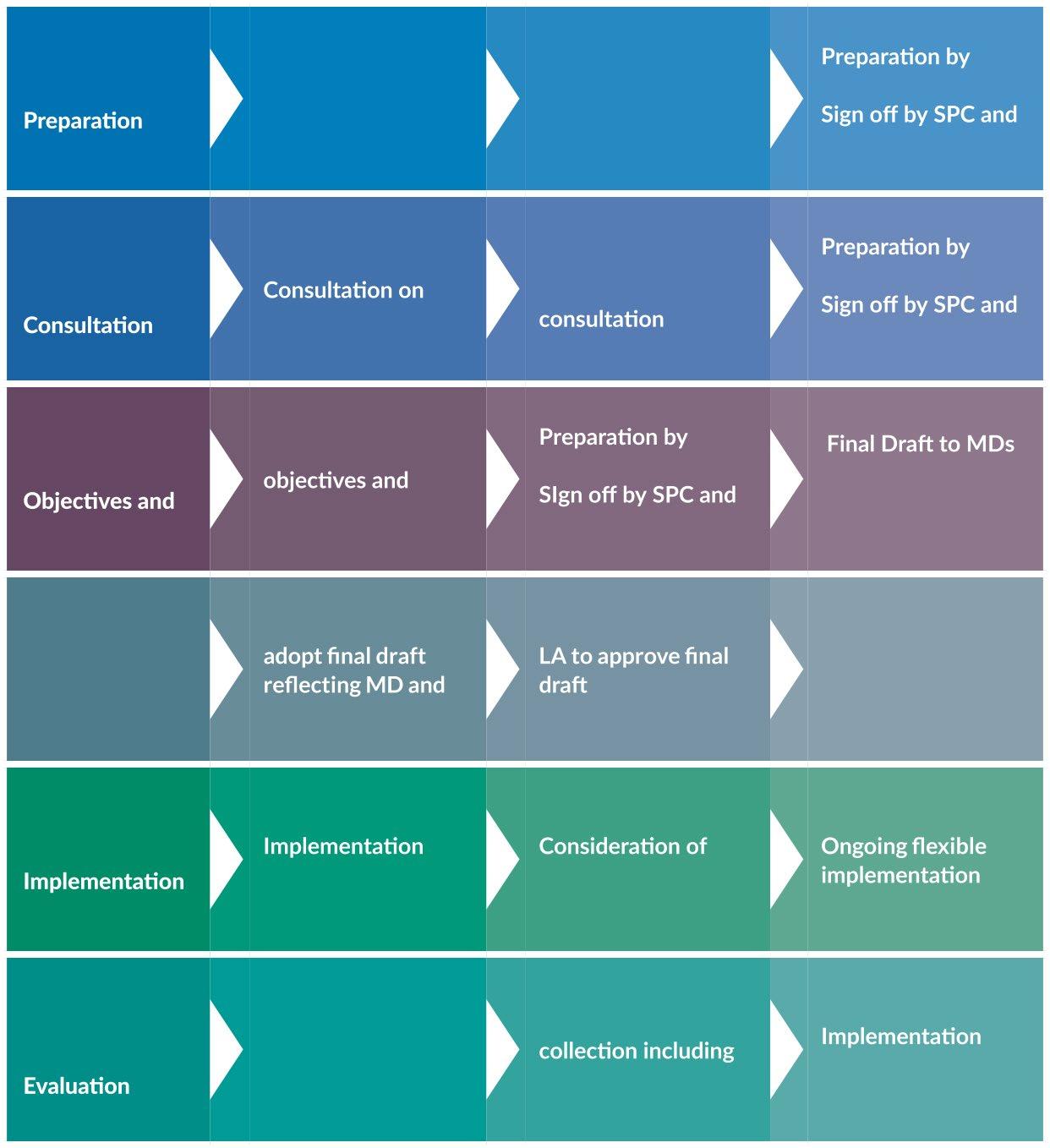

























County Meath. This stage informed the development of the Socioeconomic Statement, which included key findings
from the socio-economic analysis, a summary of what was accomplished over the course of the previous LECP, identification of key themes, and draft High-Level Goals.
During the consultation stage, the Socioeconomic Statement was issued for public review and comment. Feedback was sought from communities and stakeholders using a variety of online and in-person methods (see Chapter 6.0 for detailed methodology). Throughout the consultation stage, 7000+ participants engaged from the public, community groups, local service providers, specific sector representatives, statutory agencies, and local government.
Following the Consultation stage, the draft Socio-Economic Statement was revised and expanded to include a full policy alignment review, a socioeconomic profile, an analysis of the consultation, and an updated SWOT analysis. These components informed the revision of the High-Level Goals, and the development of Sustainable Community Objectives (SCOs) and Sustainable Economic Development Objectives (SEDOs) associated with each High-Level Goal. The revised Socio- Economic Statement was provided to the SPC, LCDC and Municipal Districts for 14 comment.
Based on feedback received from the
SPC, LCDC and Municipal Districts, a draft Framework LECP was developed. During this stage, further consultation took place with key stakeholders to identify detailed actions aligned with the agreed High-Level Goals, SCOs and SEDOs. This consultation formed the basis of the Implementation Plan, and like the development of the Framework LECP was a collaborative and iterative process. A completed draft of the Framework LECP and Implementation Plan was submitted to the SPC, LCDC and MDs for comment, and the draft was amended to reflect the feedback received. The final Framework LECP and Implementation Plan were approved by the SPC on 6th July 2023 and the LCDC on 28th July 2023, and formally adopted by Meath County Council on 2nd October 2023.
The LECP was launched in 2023. Implementation will continue from 20232029, and will include regular monitoring and review (see Chapter 9.0 for further detail of the review process). Of note, in accordance with the LECP Guidelines 2021, Implementation Plans are to be developed for a two-year period (for a total of three Implementation Plans over the lifetime of the LECP). At the two-year mark, these Implementation Plans should be reviewed and revised to respond to emerging needs.
County Meath is located in the east of Ireland, and is part of the Eastern and Midlands Regional Assembly area. The County is home to a range of geographical features, including hills and uplands areas, lowlands areas, river corridors and estuaries, and coastal areas. Meath is a predominantly rural county in terms of land use, and has a large rural population.
Rural areas within Meath are home to a diverse range of uses ranging from agriculture and equine industries, centres of local food production, recreational and tourist activities, established villages and one-off rural housing.
The County’s wealth of built heritage makes it exceptional in Ireland. It includes the UNESCO World Heritage Site of Brú na Bóinne, the seat of the High Kings of Ireland at Tara, the passage tombs of Loughcrew, the largest Anglo-Norman
castle in Europe at Trim, the historic towns of Navan, Trim and Kells, great country houses, demesne landscapes and a significant industrial heritage of canals and mills. The identity of the County is linked to its unique heritage, which is an intrinsic part of the character and attractiveness of the County and a catalyst in attracting tourism and investment.
The EMRA RSES identifies Navan as a Key Town within the Region, while Drogheda is recognised as a Regional Growth Centre in the Region. The southeastern part of County Meath is located within the Dublin Metropolitan Area, and falls within in remit of the Dublin Metropolitan Area Strategic Plan. Additionally, the RSES outlines the a retail hierarchy for the region, which identifies Navan as Level 2 (Major Town Centres and County Town Centres), and Ashbourne, Dunshaughlin, Kells, Trim, and
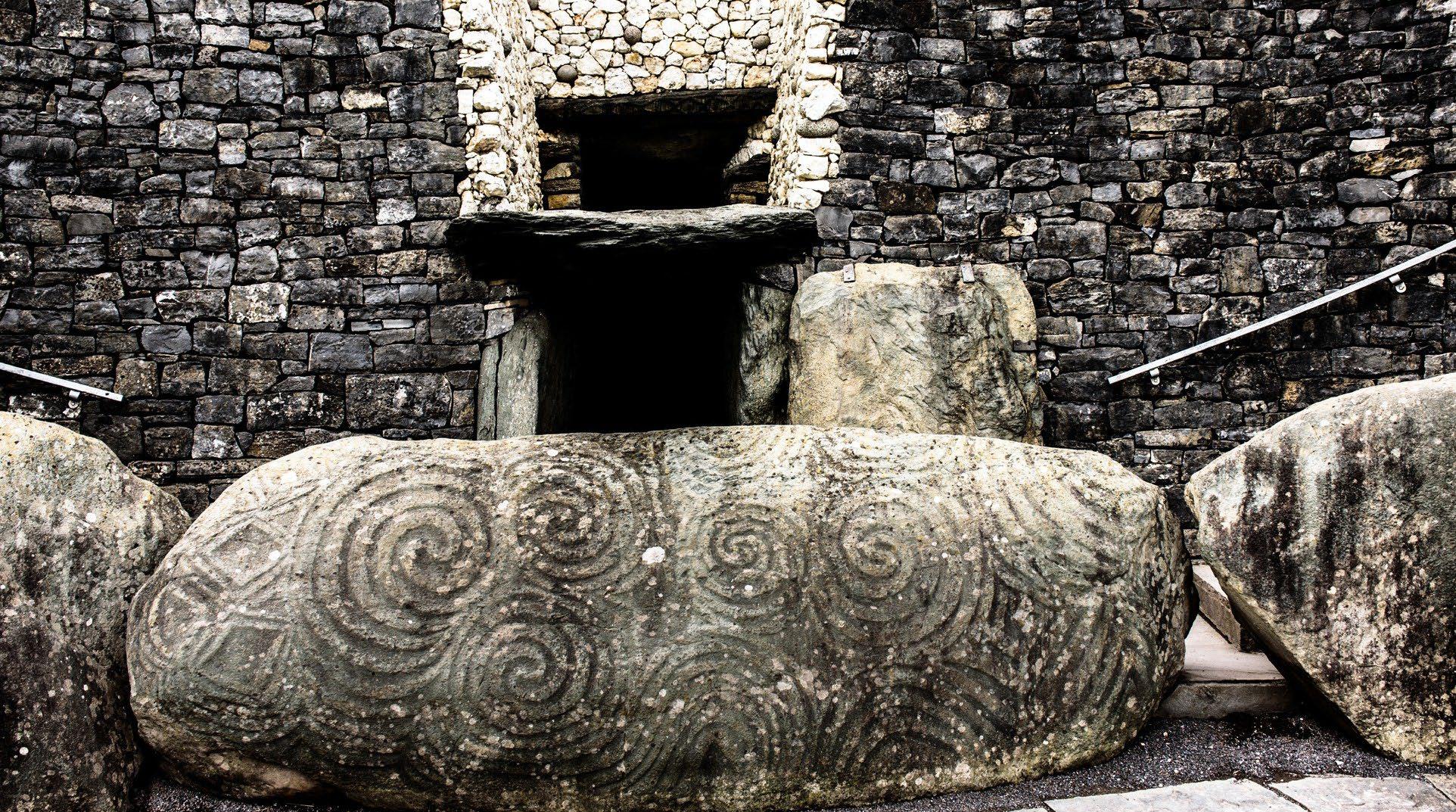
Laytown/Bettystown as Level 3 (Town and/or District Centres and Sub-County Town Centres).
The Meath County Development Plan 2021-2027 has identified seven strategic employment sites suitable for economic development over the coming years.
These sites reflect those areas with the highest incidence of outbound commuting combined with high quality skill set profile, and include: Kells, Ratoath, Dunshaughlin, Laytown, Maynooth, Navan, and Enfield.
The County is well serviced by the national road network, and the following routes all run through the County, linking the Dublin metropolitan area to the regions:
• M1 Dublin - Belfast (formerly N1, now R132)
• N2 Dublin – Derry
• M3 Cavan-Dublin (formerly N3, now R147)
• M4 Dublin to Galway, Castlebar and Sligo (formerly N4, now R148)
The national secondary roads, N51 and N52, are medium distance throughroutes connecting important towns. The N52 is a particularly important infrastructural development and strategic route, linking Dundalk and Mullingar-AthloneTullamore. The County is very reliant on its road infrastructure for intra and inter county movement and access.
The statistics below provide key facts and figures about the economy and communities of County Meath. These are the most current figures available at the time of analysis (September 2022). Over the course of the LECP 2023-2029, Meath County Council will monitor these statistics and update the LECP actions to respond to new trends and changes.
A growing population
• According to the Census 2022 results, Meath’s population is 220,826. This is projected to increase to between 225,500-231,500 by 2030


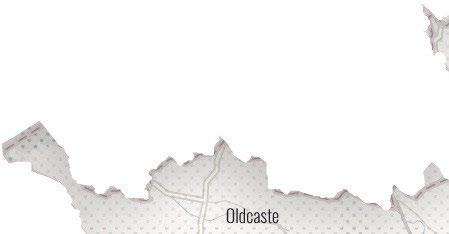
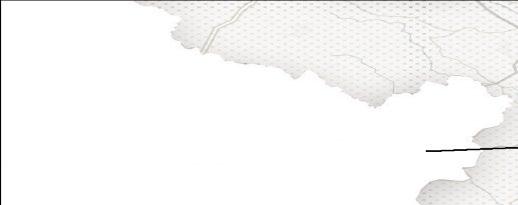
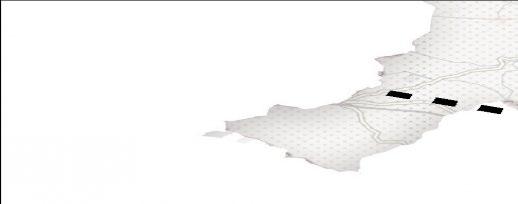
lower than the State average age (37.4)
• 29.3% of Meath’s population was under the age of 18 in 2016, the 6th highest in Ireland (CSO, Census 2016)
• The young age dependency ratio (the proportion of the population under the age of 15 as a % of the working age population) stands at 39%, notably higher than the State figure of 32.3%.
• 194 childcare services in Meath (170 private and 24 community) (Pobal 2020/2021)
• €191.52 was the average weekly cost of childcare in 2021 (Pobal 2020/2021)
An ageing population
• In 2016, of Meath’s total population, 25% were under the age of 15 years, 64% are between 15-64 years, and 11% are age 65 or over (CSO, Census 2016)
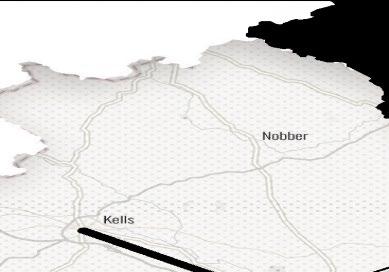



























• Over the last decade, County Meath's growth rate was higher than the Eastern and Midland Region and the State



• Between 2016-2022, the population in Meath increased by 13.2%, the second- highest increase in both the Region and the State (CSO, Census 2022)
• Between 2011 and 2016, the population of people in Meath aged 85+ years increased from 1,600 to 1,991 (CSO, Census 2016).
good health

























• In 2016, the population was predominantly urban, with over 59% of residents living in satellite or independent towns. However the county also has a number of smaller towns and villages, many of which have a strong rural character
A young population
• 65% of people in Meath reported they were in very good health in 2016, approximately 2% higher than the State proportion (CSO, Census 2016)
• 11.1% of people in Meath had a disability in 2016, lower than the State rate (13.5%) (CSO, Census 2016)







• The average age in Meath was 35.2, the second lowest in the State, and
• Meath recorded a suicide rate of 5.8 per 100,000 population in the 2016– 2018 period, lower than the national rate at 8.2 per 100,000 population. (Healthy Meath Plan 2019–2021).
• 11.1% of people in Meath had a disability in 2016, lower than the State (13.5%) (CSO, Census 2016)
• 426 Children in Meath had an intellectual disability (12th highest in the State) (State of the Nation’s Children report 2016)
• 597 children were registered wi th a physical/ sensory disability in Meath, which was the third highest registration rate in the State (State of the Nation’s Children report 2016).
High proportion of family households
• Meath had the highest proportion of households consisting of couples with children (44.4%) among all the Counties in the State. Between 2011 and 2016, this proportion increased in all Municipal Districts except for Ratoath
• In 2016, County Meath had the highest proportion of married people (39.9%) in the Eastern and Midland Region.
• In 2016, Meath had the second lowest proportion of single parent households (9.7%) in the region (CSO, Census 2016).
Unique rural/ urban population split
• Although the majority of Meath’s population (59%) lived in an urban setting, 41% of the population lived rurally, which was higher than the State proportion (37%) (CSO, Census 2016)
•
population figures, the average population density in Meath is approximately 94.1/km², compared to the State average of approximately 72km² (CSO, Census 2022).
Key findings:
Meath has a fast-growing population. While the majority of people live in urban areas, there is a higher proportion of people living rurally or in towns and villages than the national average. While the age profile of the County is young relative to other counties, there is also an increase in the proportion of older adults, following the national trend.
The County generally enjoys good health, and reports a low proportion of people with disabilities compared to the State.


65% of people in Meath reported they were in very good health in 2016, approximately 2% higher than the State proportion.

597 children were registered with a physical/ sensory disability in Meath, which was the third highest registration rate in the State


€191.52 was the average weekly cost of childcare in 2021

220,296 people living in Meath.This is projected to increase to between 225,500-231,500 by 2030

426 children in Meath had an intellectual disability12th highest in the

194 childcare services in Meath (170 private and 24 community)
Distinctive industries and employment profile
• There was a higher proportion of households in Meath reporting the following employment types than at the State level: employers and managers; manual skilled; own account workers; and agricultural workers
• As of 2019, the majority of enterprises in Meath (92.7%) were small (under 10 employees). This was slightly higher than the regional and State levels (91.4% and 92.1% respectively)
• Meath had a low proportion (0.1%) of large businesses (over 250 employees) compared to the region (0.4%) and the State (0.3%)
• Major employment industries include: Agri -food and forestry, Mining, quarrying and turf production,
Manufacturing, and Transportation, storage, and communications
• The tourism sector was uniquely affected by Covid-19. According to the CSO, In 2021 Irish residents took 96 thousand trips (down 59% from 237 thousand in 2019) and spent roughly 11 million EUR in Meath (down 65% from roughly 30 million EUR in 2019)
Meath is home to...
• Global Top 10 ICT Company
• EU HQ Bioscience Centre for World’s Top Bio-Pharma Company
• Ireland’s largest Avoca store
• Boyne Valley Food - a national food destination
Tourism
• In 2022, the UNESCO World Heritage Site of Brú na Bóinne generated the biggest increase in visitor revenue of
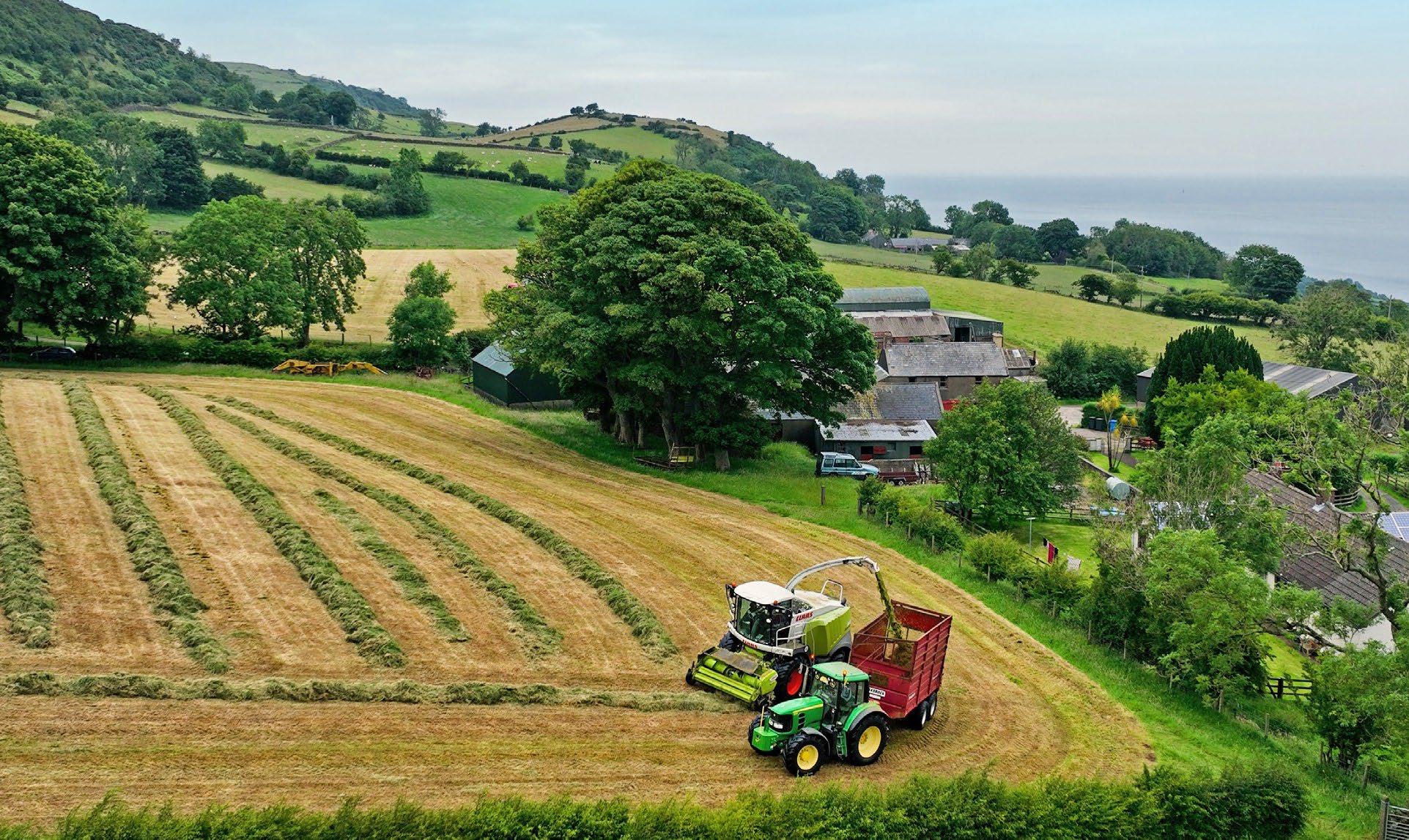
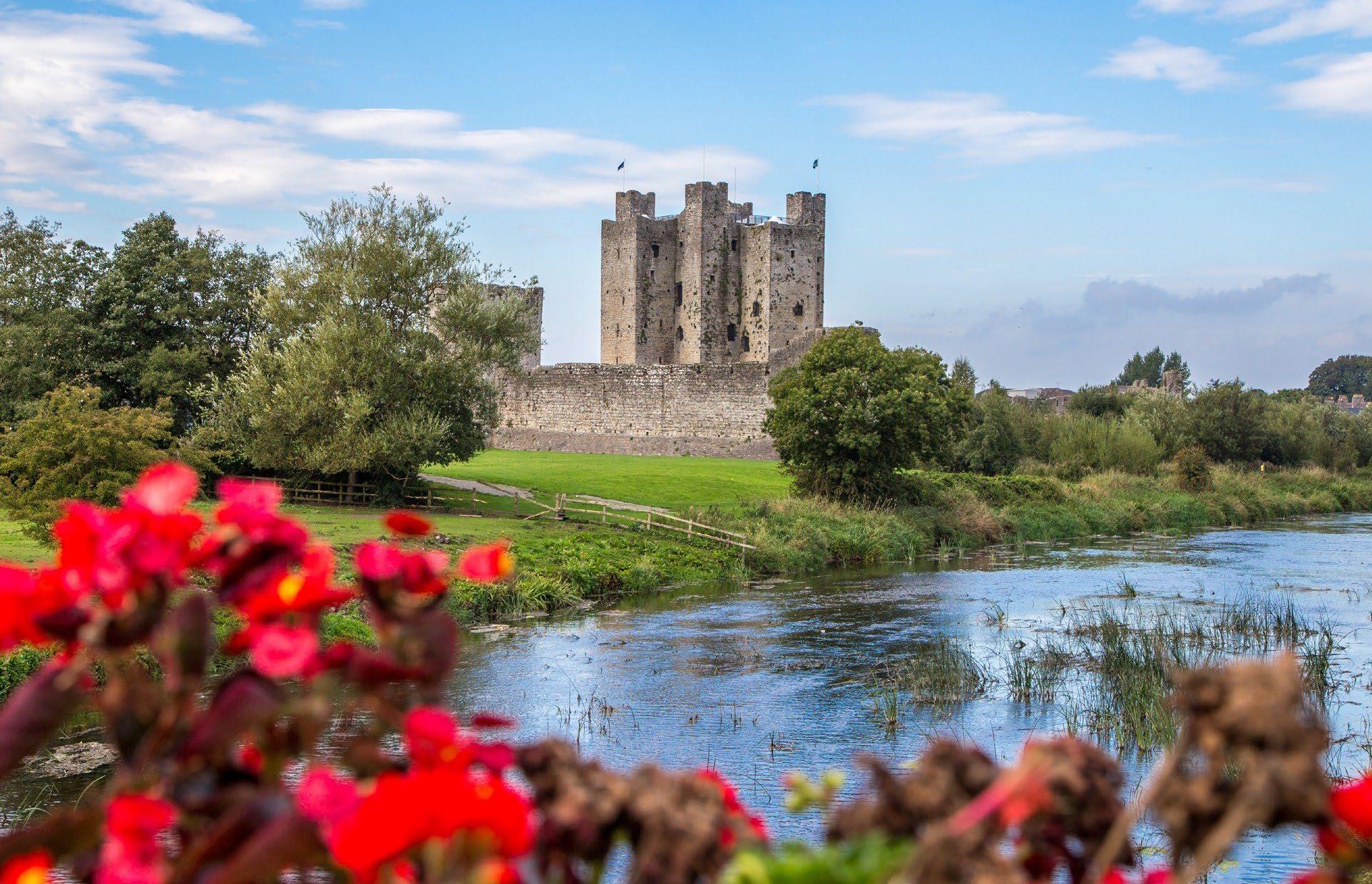
all National Monuments in the country, collecting €774,085 by the end of August, compared to just €575,000 in 2019
• Meath is home to eight Office of Public Works (OPW) Heritage Sites (Office of Public Works website https:// heritageireland.ie/visit/places-to-visit/) and Emerald Park
• The Boyne Valley Region, located predominantly within Meath, features the ancient heritage of the area, and is the key focus of Fáilte Ireland's Ancient Destination Experience Development Plan
• 88.8% of respondents were employed in 2016, which accounted for a Labour Force Participation Rate of 64.2% (CSO, Census 2016)
• 82,605 resident workers in the County in 2016 (CSO, Census 2016)
• As of 2020, there were roughly 13,354 local businesses in Meath (Meath Economic and Community Monitor)
• In 2019, Meath recorded a disposable income per person of €21,674 which was the sixth highest in the Country
• 40,000 jobs located within Meath (Meath Economic and Community Monitor)
• Between September 2021-2022, there was an average of 3,911 people on the Live Register, and as of December 2022, there was a total of 3,774 people on the Live Register in Meath (CSO, Live Register 2022).
• Unlike the Eastern and Midland Region and the State, there are more women on the Live Register than men in
County Meath
Deprivation rates at the County level
• At the County level, Meath is classified as marginally above average (compared to other Counties) on the Pobal Deprivation Index, which measures relative affluence/ deprivation (HP Pobal Deprivation Index, 2016)
• However, at a finer grain, spatialized deprivation becomes apparent, with pockets classified as very disadvantaged centred in Trim and Navan (HP Pobal Deprivation Index, 2016)
• In 2016, the median annual household gross income in Meath was €52,156, higher than the State (€45,256) (CSO, Census 2016)
• The Kells Urban ED is classified as an unemployment blackspot, the only one in Meath
• In 2016, 48.5% of the population in Meath reported an education level above upper secondary school. This was slightly higher than the State figure (48.1%) (CSO, Census 2016)
• A relatively high proportion of the population in Meath availed of tertiary education outside of university, with 16.6% completing an apprenticeship or vocational certificate compared to 13.7% at the regional level and 14.7% at the State level (CSO, Census 2016)
• In 2016, the most common
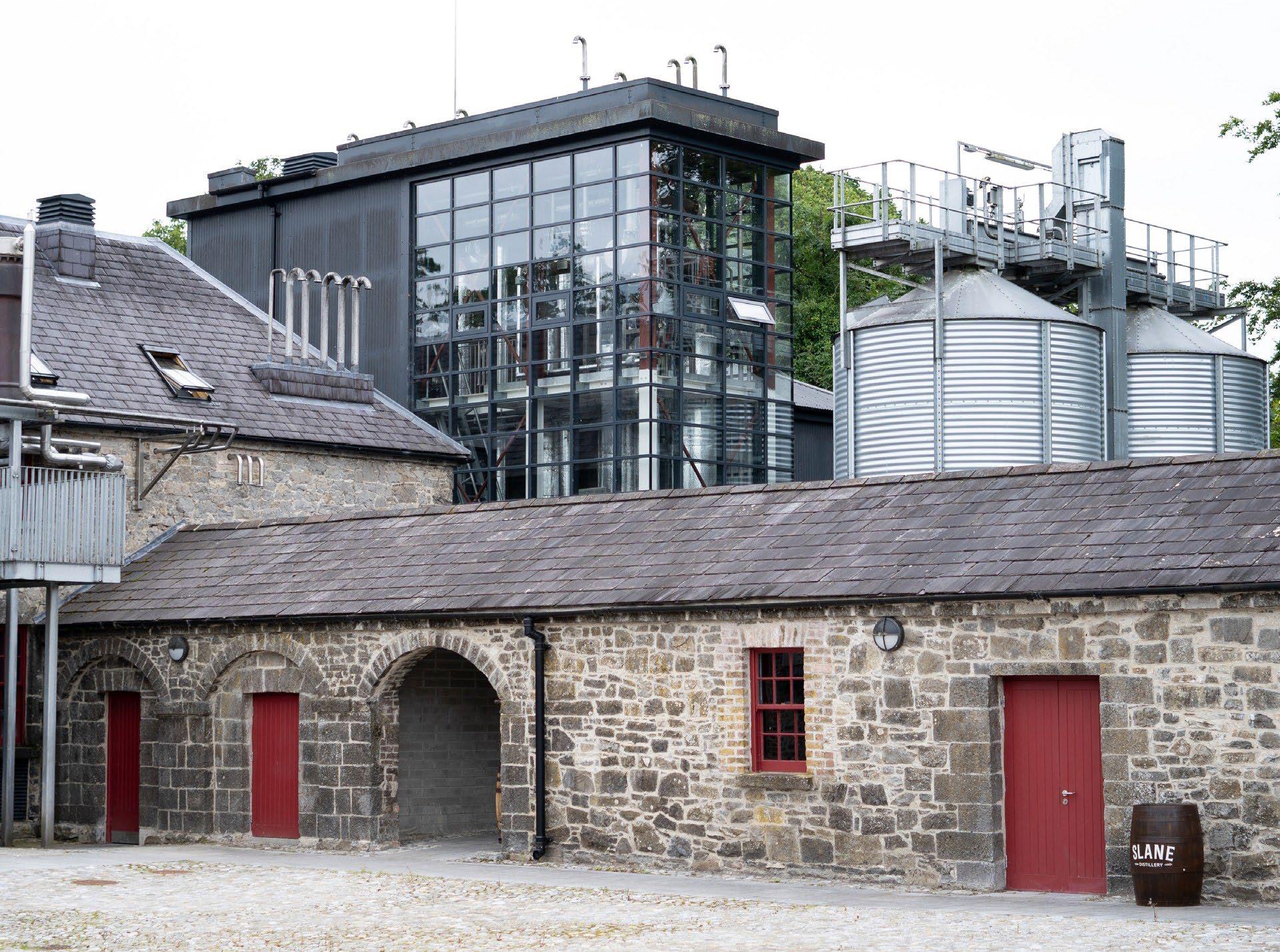

• qualification among men was engineering, manufacturing, and construction (37.8%), and among women it was social sciences, business, and law (35.0%). With the recent emerging fields of technology and construction in Meath, there was an under representation of women with relevant qualifications (with, 2.9% of women attaining a qualification in engineering, manufacturing, and construction). However, 22.9% of women were qualified in health and welfare (CSO, Census 2016)
• In 2021, 43.4% of Leaving Cert students in Meath progressed to university, similar to the region (43.3%) and slightly higher than the State rate (42.7%) (HEA, 2021)
• The Dunboyne College of Further Education and the Louth Meath Education and Training Board provide third-level education within the County
• 25,377 workers travel to work within the County and 36,460 commute to work outside the County (Census 2016)
• 59% of respondents to the Meath Commuter Survey reported that they travel outside the County to work, with 4 in 5 (80%) travelling by car, and 13% by train or bus. Navan had the largest number of worker residents, while Ratoath /Ashbourne has the highest number of people commuting outside of the county to work (Meath Commuter Survey)
• Outside the County, Dublin City was reported as the location most-travelled to for work by Meath commuters (13,362 people), while 10,133 Meath residents reported traveling to Fingal for work
• Within the county, Navan is the most commuted-to destination for work, followed by Trim
• In 2016, 82% of Meath’s working population travelled to work by private vehicle, compared to 73% nationally (CSO, Census 2016)
• Public transportation was used as a means of commuting by 7% of commuters in Meath (compared to 9% nationally), while 6% of commuters travelled to work by foot or bicycle (compared to 12% at the State level) (CSO, Census 2016)
• The highest proportion of commute times (32.9%) were under 15 minutes, with 25.4% of commute times lasting between 15-30 minutes. However, 11.6% of people commute for between 60-90 minutes.
• County Meath had the highest proportion of households with 2 motor cars in the State.
• County Meath had the highest proportion of people starting their commute before 7 am in the State.
Access in and out of the County
• The motorways and national roads traversing County Meath (M1, M2/N2, M3/N3 and M4/ N4) and connections with the M50 Dublin orbital route offer ease of access to national and international markets
• More than half of people in Meath (54.4%) lived less than 5km away from a primary or secondary national road, though this was lower than the national average of approximately 70%
24 (CSO 2019, Measuring Distances to
Everyday Services)
• The Transport Strategy for the Greater Dublin Area (2022-2042) plans for the delivery of the rail line to Navan
• The DART expansion Programme plans for new infrastructure and electrification of existing lines, including provision of electrified services to Drogheda, Maynooth and M3 Parkway on the Maynooth/Sligo Line (Meath CDP 2021-2027)
• 73.5% of the people in Meath have more than 10 departures a day at their closest public transport stop (less than 10 departures a day is considered low-frequency service) (CSO 2019, Measuring Distances to Everyday Services)
• Close proximity to Dublin Airport and Dublin Port.
Key findings:
Meath has a unique economic landscape, with top employment industries including: Commerce and Trade, Professional Services, and Manufacturing Industries. The County is home to a fast-growing Agri -food sector, while tourism is also important component of the local economy. The unemployment rate in the county is generally low with the third highest labour force participation rate nationally, reflecting the strong economic conditions in Meath. The pharmaceutical, technology, and retail industries are also growing in Meath, providing employment opportunities in various fields. Additionally, the county is home to several large multinational companies, further boosting the local economy.
At the County level, Meath has a fairly low deprivation rate. However, at a fine-grain level spatialised deprivation becomes apparent, with pockets of high deprivation found in Trim and Navan. The County has high educational attainment rates, and a higher proportion of people in Meath avail of apprenticeships or vocational certificates than at the national level. Meath is well -connected to other counties and is served by several National Roads. More than half of the people (54%) in Meath lived 5km or closer to a primary or secondary National Road, though this was 16% lower than the State figure. This connectivity to other counties, particularly Dublin, has made Meath a popular location for commuters, with more than half of workers commuting to a job outside the County. There is
particularly high car dependence, and the rates of people commuting to work by public transportation or active transport (on foot or bicycle) were lower than at State levels. However, the number of people working from home has significantly grown since Covid 19; this is likely to reduce the number of people commuting outside of Meath to work. As such, remote working has the potential to increase footfall in Meath’s towns and villages as people are in a position to enjoy their locality.


€21,674 in disposable income per person in 2019, which was the 6th highest in the Country

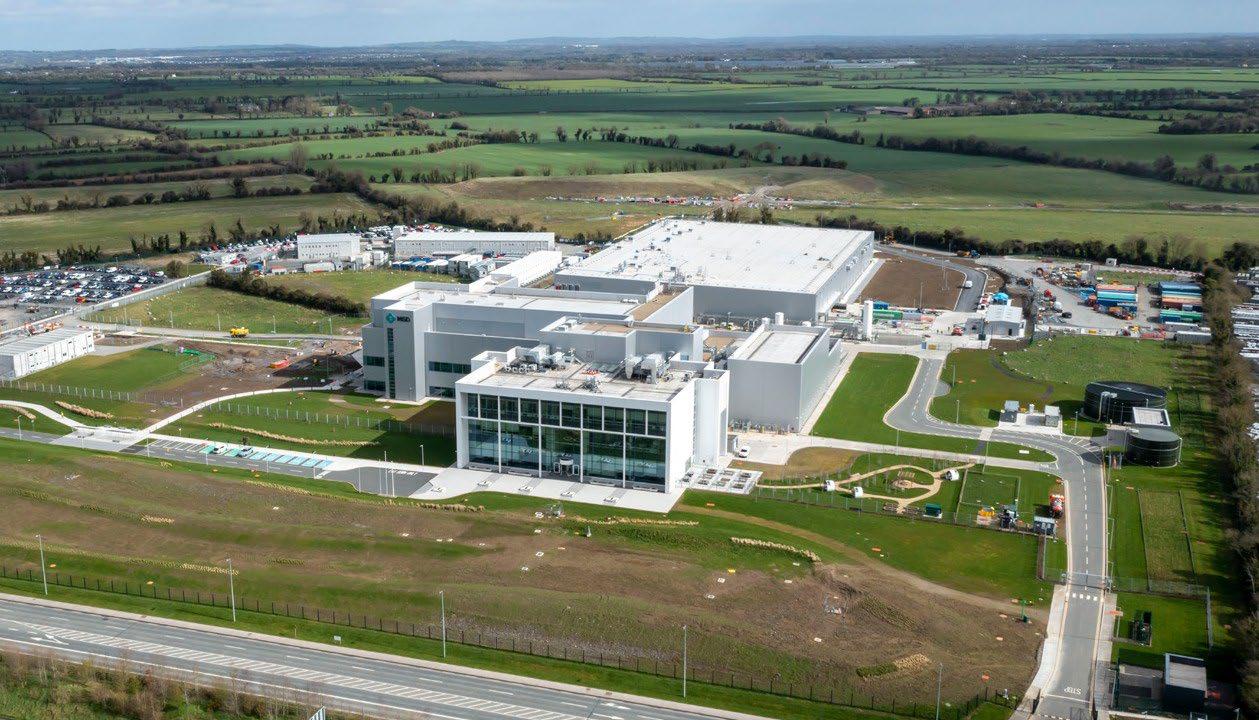
73.5% of the people in Meath have more than 10 departures a day at their closest public transport stop

40,000 jobs located within Meath.


48.5% of the population in Meath reported an education level above upper secondary school in 2016. Slightly higher than the State figure (48.1%)

Rich in culture and heritage
• Meath is the only County in Leinster to have Gaeltacht regions
• Meath County Council recognises the importance of placemaking and the value of high-quality public realm to our communities. The Council has completed 7 public realm plans to date which are being implemented with funding from the URDF, RRDF, ORIS, NTA etc.
• There are 23 Arts and Culture Groups registered with Meath’s Public Participation Network

€52,156 the median annual household gross income in County Meath higher than the State average (€45,256)

30 minutes to Dublin Airport and Dublin Port.
• There are over 3,000 monuments and heritage sites in Meath (meathheritage.com)
• Brú na Bóinne is one of only two UNESCO World Heritage Sites in Ireland
Good proximity to general health care
• According to the HSE, there are 17 Health Centres in Meath5
• According to CSO, in 2016 people in Meath lived on average…
• 2.7km from a pharmacy (State average: 2.8km)
• 3.2km from a general practitioner (State average: 3.1km)
• 14.1km from an emergency department (State average: 20.1km)
Crime is relatively low
• In 2022, the 16 Meath Garda divisions recorded 5,304 crime offences.
• The number of recorded criminal offences has risen between 2021 (4,908) and 2022 (5,304)
• There are 16 Garda stations in Meath. Of these, Navan reported the highest number of criminal offences in 2021 (1,439), followed by Ashbourne (703), and Laytown (582). Offending is decreasing under the various
categories of crime related to Assault Causing Harm, Minor Assaults, Theft (other), Theft from vehicle, property crime, crime against the person and criminal damage (Crime Trends 2020)
• In 2019 Meath had the third lowest prison re-offending rate in the Country at 35%, significantly lower than the State (44.6%)
Robust networks and partnerships
• There are 40 elected members of Meath County Council
• Based on a 40 Local Authority Membership, 19 people sit on the Local Community Development Committee (LCDC) for Meath. Membership is 51% Non-Statutory and 49% Statutory
• Meath County Council has several Strategic Policy Committees (SPCs), including the Environment and Emergency Services SPC, the Housing, Community and Cultural Development SPC, the Planning, Economic Development, Enterprise and European Affairs SPC, and the Transportation SPC
• Meath’s Public Participation Network currently has 590 member groups from the Community and Voluntary, Social Inclusion and Environment sectors.
Home to new communities (CSO, Census 2016 unless otherwise noted))
• In 2016, approximately 14% of census respondents reported being an ethnicity other than White Irish, a lower 28 rate than the State (15.6%), and the
second lowest rate in the region
• There was 5 Irish Travellers per 1,000 total population in Meath, slightly less than the State (6.6 Irish Travellers per 1,000 total population
• In 2016, the majority of Travellers in County Meath lived in Navan town (664 in total or 2.2% of the population), which was higher than both the county proportion (0.7%) and the State proportion (0.5%)
• Of Meath’s total population, 10.2% reported their nationality as nonIrish, the third-lowest rate of nonIrish nationals in the region, and lower than the State proportion of non-Irish Nationals (11.6%)
• In 2016, County Meath had the third highest proportion of Lithuanian nationals in the State
• There are pockets of high ethnic and national diversity. In Navan Urban, 38.5% of the population reported being an ethnicity other than White Irish, and 31.1% of the population reported being a nationality other than Irish
• As of December 11, 2022, approximately 1,835 Ukrainian refugees had been issued a PPSN, and listed a local post office address in Co. Meath. The highest proportion of Ukrainian refugees in Meath (42%) reported their local post office address in the Ashbourne MD.
• According to preliminary Census 2022 results, there are approximately 79,224 dwellings in Meath
• Between 2016 and 2022, County Meath had the greatest proportional increase in housing stock in the State
• The vacancy rate dropped from 6.6% in 2016 to 5.5% in 2022. This is lower
than the State vacancy rate of 7.8%. The vacancy rate is highest in Kells (8.3%)
• As of October 2022, there were 3,311 households in Meath that qualified for social housing support (The Housing Agency 2022, Households Qualified for Social Housing Support)
• Meath had the highest proportion of caravans/mobile homes in the region (0.6%), higher than the State proportion of the same (0.3%) (CSO, Census 2016)
• According to the 2021 Annual Count of Traveller Families, there was an estimated 475 Traveller families
i n Meath. Of these families, 53% were in social housing or receiving housing support from the Local Authority, 35% were renting privately, 9% of households were deemed to be sharing with families, and 2% of households were recorded as residing on un-authorised sites6
• As of November 2022, there were 190 homeless adults accessing emergency accommodation in Meath (Department of Housing, Local Government and Heritage 2022, Monthly Homelessness Report)
• The new dwelling completion rate is rising in Meath but at a slower rate than in the Eastern and Midland Region and the State
• Unlike the Eastern and Midland Region and the State, the number of HAP properties decreased in County Meath between 2020 and 2021
• The median property purchase price in County Meath is rising, but at a slower rate than the Eastern and Midland Region.
Key findings:
Meath has a rich cultural heritage. Meath is the only County in the Leinster province to have Gaeltacht regions and is home to one of only two UNESCO Heritage Sites in the country (Brú na Bóinne). The County is relatively safe, with low and decreasing crime rates. Residents have comparably good access to health care services, including pharmacies and GPs.
There is a strong network of community organisations throughout the County, with over 450 organisations and community groups registered as members of the Public Participation Network.
The population of Meath is diverse and includes a mix of Irish, European, and international residents. Meath has diverse communities, including refugees, asylum seekers, and Irish Travellers. Ashbourne has seen the highest settlement of Ukrainian refugees over 2022, while the Mosney Direct Provision Centre hosts refugees and asylum seekers in the east of the County. Navan is home to the highest ethnic and national diversity in the County, including a significant Traveller community.
There is significant housing development in Meath, and a lower vacancy rate in the County than at the State level. The national housing crisis continues to impact the County, and homelessness and the need for social housing support are ongoing challenges.

A focus on preservation and conservation
• Meath has a Climate Action Strategy, and a Climate Action Team (Meath County Council website)
• 13 Special Areas of Conservation (Meath County Development Plan, 2021-2027)
• Four Special Protection Areas (Meath County Development Plan, 20212027)
• Mornington beach was awarded a Green Coast award in 2022, indicating excellent water quality and sustainable management by Meath County Council and the Mornington Beach Management Committee (An Taisce, 2022).

475
There was an estimated Traveller families in 2021 in Meath.

The vacancy rate dropped to 5.5% in 2022 from 6.6% in 2016. This is lower than the State vacancy rate of 7.8%.

• Seven towns/villages have developed Community Biodiversity Action Plans, including Julianstown, Kells, Longwood, Ráth Chairn, Ratoath, Slane and Dunshaughlin (Meath County Council website)
• In 2021, Meath reported 44 total hectares of afforestation (13ha of broad leaf and 31ha of conifer). This was the 12th lowest afforestation rate in the State (CSO, Afforestation Area 2021)
• Three confirmed Natural Heritage Areas in Meath, and 18 further proposed Natural Heritage Areas (Meath County Development Plan 2021-2027)
Eco-friendly waste management (Meath Economic and Community Monitor)
• Co. Meath has the third highest percentage of recycling bin collection services in the country
• In 2019, Meath recorded 8.7% of waste to be brown bin organic waste. This means Meath was ranked 15th out of 30 counties/settlements that reported their waste figures
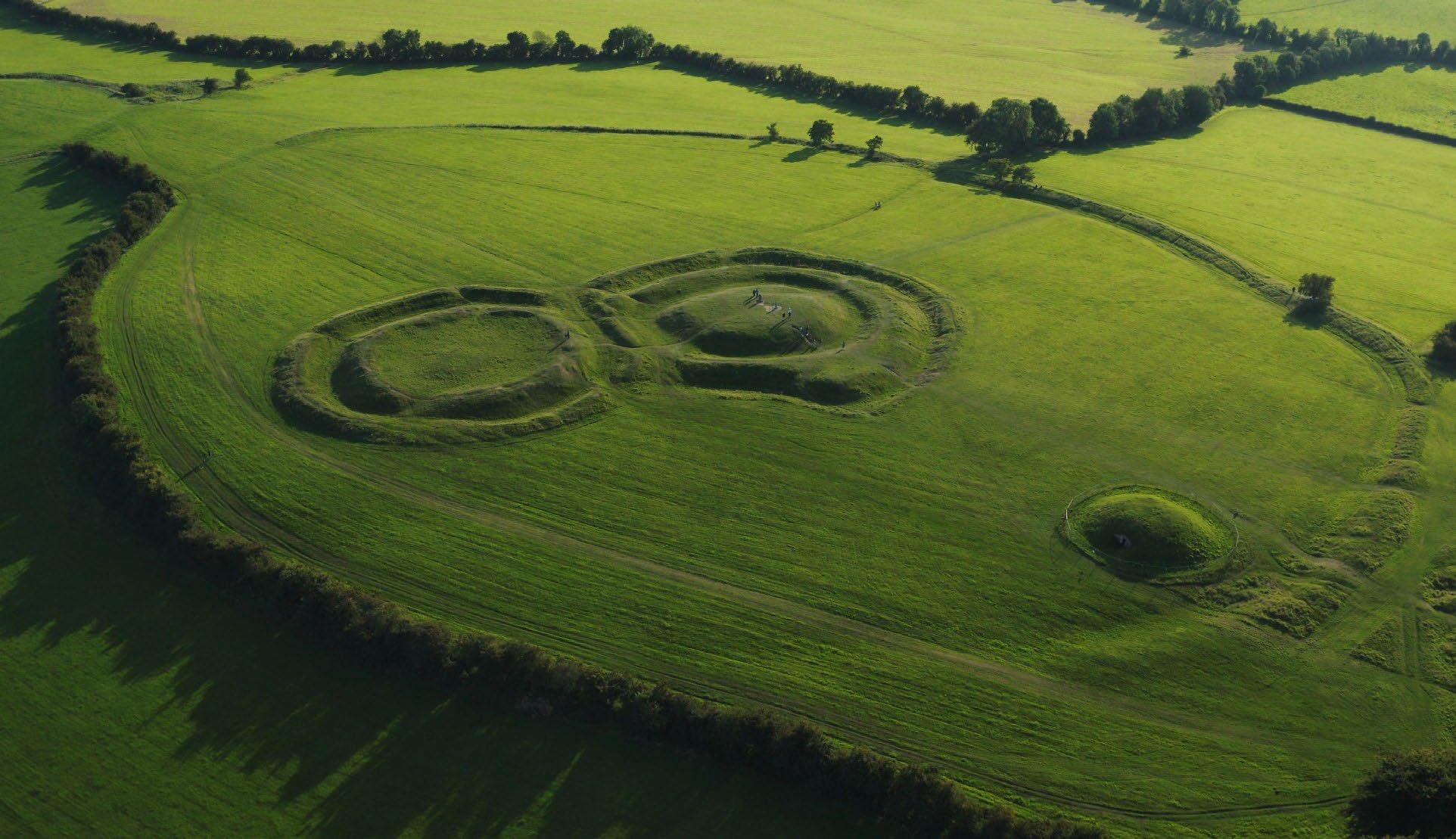
• In 2019, Meath recorded 49.7% of waste to be black bin waste, higher than both the region and State figures (38.9% and 41.6% respectively). Meath recorded 12.4% of waste to be recyclables, the fifth lowest in the State.
Water infrastructure (Meath Economic and Community Monitor)
• In 2016, the highest proportion of households reported Public Main as their water supply, and 19% reported getting water from another, private source
• Average water consumption in litres per meter per day: 37.
• The current daily water demand in County Meath is c. 40,000m3/day.
High numbers of cars per household
• Meath reported the lowest proportion of households with no car in the Region and the State and the highest proportion of households with two cars (44.3%), three cars (7.5%) and four cars or more (2.7%) in the Region and the State (CSO, Census 2016).
High uptake of Electric Cars
• Across 2021-2022, 1085 electric vehicles were registered as private cars in Meath. This was the fourth highest number of EVs registered in the State, trailing only Dublin, Cork and Kildare. In Meath, electric vehicles
represented 8.3% of the vehicles registered in 2021-22 this was higher than the corresponding proportion of the State.
• In 2021, Meath was the 6th highest consumer of residential metered electricity in the State, with 375 gw hours recorded and the 11th highest consumer of non-residential metered electricity, recording 346 gw hours (CSO, Electricity Consumption)
• In 2016, the highest proportion of houses in Meath (48.7%) were heated with oil. This was high compared to the State level (40.4%) (Meath Economic and Community Monitor).
• In 2020, Meath had a significantly higher proportion of domestic buildings rated A (17.8%) compared to the State (8.4%). Meath also had lower proportions of domestic buildings rated B1, D1, E1, F, and G compared to the State (Sustainable Energy Authority of Ireland, 2021).
Meath has a strong focus on preservation and conservation, and has committed to biodiversity and climate action plans at the County level, and several towns have developed local biodiversity action plans. While there is a high proportion of recycling services in Meath, there is a comparatively low uptake of recycling. The majority of houses in the county are heated with oil, and the county was the 6th highest consumer of residential metered electricity in 2021. However, Meath also has a high proportion of homes with high building energy ratings compared to the State. As noted above, the County has a high dependence on private vehicles, and in 2016 Meath reported the lowest proportion of households without a car in the State.
In 2021-2022, the County reported the registration of a higher proportion of electric Vehicles than the State.


37 litres in the average water consumption in County Meath per day. In 2022, Meath was the 6th highest consumer of residential metered electricity in the State, with 342 gigawatt hours recorded.
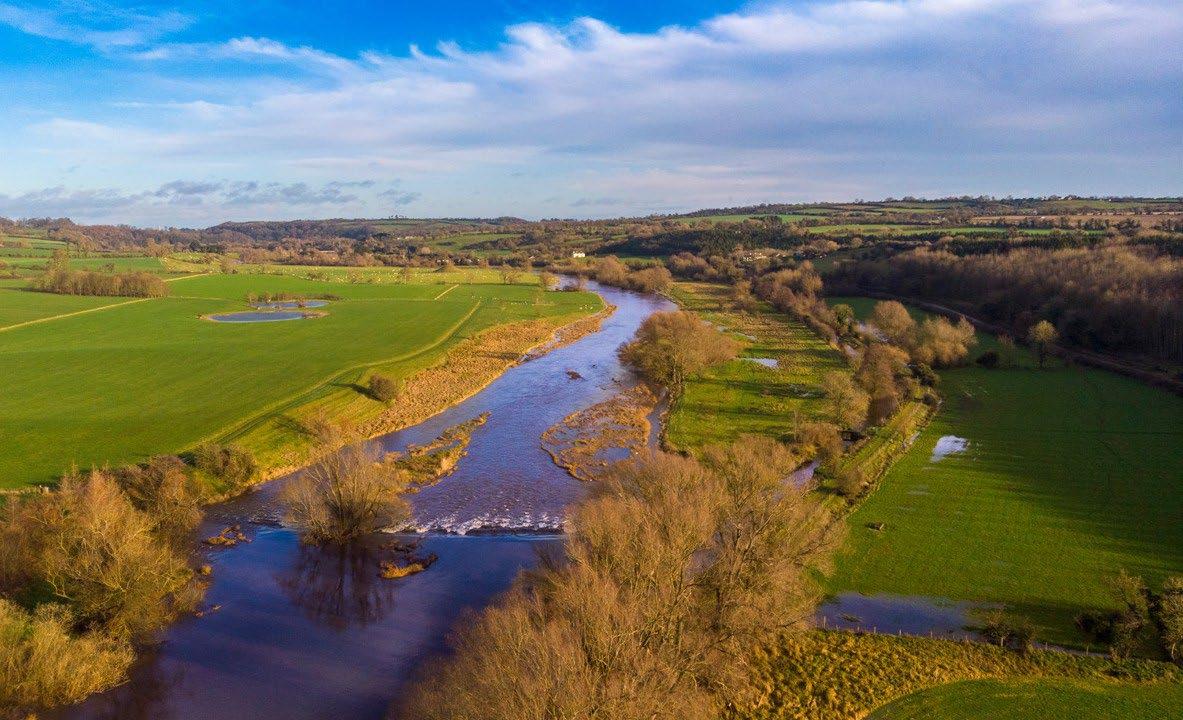

13
Public consultation was focused on refining the draft High-Level Goals, as well as identifying potential objectives and actions to fit within each goal.
Participation in public consultation was invited from October through December 2022. A variety of engagement methods were provided in order to ensure access to the public consultation process to as many people across the county as possible. Those wishing to make submissions were invited to refer to a Socio-Economic Statement prepared by Meath County Council to support the public consultation phase.
Both in-person and online consultation methods were utilised. Invitation was extended to this process via press release, media activity, a social media campaign, and a dedicated webpage on the Meath County Council website to engage in the following consultation processes.
In total, over 7,000 people engaged with at least one component of the consultation process. A detailed consultation timeline can be found in Appendix 2, and the engagement numbers and demographics of those that responded to the surveys are illustrated on the next page.

special areas of Conservation .


38% of all households in County Meath are using enewable energy.






In 2021, Meath reported 44 total hectares of afforestation. This was the 12th lowest afforestation rate in the State. There is 4 special protection areas in County Meath.


Sector & Statutory Representative s
The public consultation phase of the LECP was carried out from October to December 2022.


27 people registered for a public feedback and information session

300+ engaged during on street popups across 10 locations
5 submissions via www.consult.meath.ie

153+ public survey responses

56+ business survey responses



60+ participants across 10 focus groups
5,000+ people engaged online via 5 social media platforms
1,500+ followers across social media platforms
The public were asked how strongly they understood the six DRAFT high level goals and rank how important it was to them. The High Level Goals were updated and ammneded to reflect this
feedback.
Goal 1: A healthy and resilient County
Goal 2: A dynamic economy that supports and meets the needs of its businesses and people
Goal 3: Empowered, inclusive and equitable communities
Goal 4: Safe, accessible and enriching places
Goal 5: A County that works together
Goal 6: A sustainable and eco-friendly County





























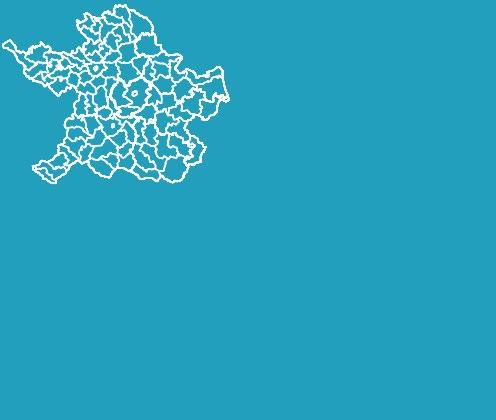





f o r e i g n i n v e s t m e n t d y n a m i c e m p l o y m e n
A crucial component of public consultation is ensuring the LECP reflects the feedback shared during the consultation process. The following table presents a summary of the feedback received around the draft High-Level Goals, and shows how the final goals were adapted to reflect the input from the public.
Goal 2: A dynamic economy that supports and meets the needs of its businesses and people
Goal 3: Empowered, inclusive and equitable communities
The word dynamic is unclear in this context, and “meets the needs of its businesses and people” could be more specific to Meath.
The word equitable is not accessible to all readers. This goal requires action and follow-through, and would feel more meaningful if the language was active rather than passive.
Goal 4: Safe, accessible and enriching places
There are too many major themes combined in this goal, and the language could be changed to be more specific to Meath. Increasing tourism and improving the public realm are key priorities.
The goal was changed to: A county that actively encourages and supports a growing economy and workforce
The goal was changed to: A County that welcomes, empowers, and includes all communities
The goal was changed to: A County that celebrates and promotes its rich culture and heritage and is attractive to residents and visitors
Goal 5: A County that works together
This goal was relatively easy understand and captures a key priority for the County, however, a little vague.
This goal was changed to: A County that works together to achieve the common good
Goal 6: A sustainable and eco-friendly County Language that aligns with the Meath Climate Action Plan would make this goal feel more concrete and meaningful.
Additional feedback Transportation and connectivity are a key priority area that cross-cuts the other goals, however, a dedicated goal may be beneficial.
The goals order should be reshuffled to ensure there is no priority order.
5.4 Key themes that emerged from consultation
In addition to shaping the High-Level Goals, feedback from the consultation process informed the Sustainable Community Objectives (SCOs), the Sustainable Economic Development Objectives (SEDOs) and their associated
1: A sustainable and ecofriendly County that is committed to climate action
GOAL 2: A connected and accessible County
The goal was changed to: A sustainable, eco-friendly County that is committed to climate change
The following HighLevel Goal was added: A connected and accessible County
The goals were reordered and assigned different numbers.
actions. An overview of the SCOs and SEDOs can be found in Chapter 7.0, and further detail. The table below is organised under the revised High-Level Goals (see section 6.3 above), and presents the key themes that emerged during consultation.
County-level coordination and leadership around sustainability and climate change actions
Increased focus on biodiversity, preservation and conservation
Prioritising regeneration and redevelopment
Increasing sustainable farming practices
Promote the use of more sustainable modes of transport
To support economic activity and growth by improving the opportunity for people to travel for work or business where and when they need to, and facilitating the efficient movement of goods.
Promote living and working in Meath
GOAL 3: A healthy and thriving County
GOAL 4: A County that works together to achieve the common good
GOAL 5: A County that celebrates, protects and promotes its rich culture and heritage, and is attractive to residents and visitors
Increased education and promotion around physical and mental health
Increasing demand for physical and mental health services
Social infrastructure development commensurate with new housing development and population growth
Community and personal safety
Increased networking between statutory bodies and not-forprofit organisations and agencies
Encouraging public involvement
Coordinated approach to service development and delivery
Improving public transportation
Encouraging tourism
Enhancing public safety
Equal access to high-quality public realm and green spaces
6.1 Vision
“
An economically vibrant, and environmentally sustainable County that offers a high quality of life for its diverse communities.
”
GOAL 6: A County that welcomes, empowers, and includes all communities
Continued and increased community integration and inclusion
Tailored supports, services and opportunities
Access to supports and services
Addressing housing challenges
Emphasise and build on the current strong community leadership
Asylum Responses
Tailored supports, services and opportunities
Access to supports and services
GOAL 7: A county that actively encourages and supports a growing economy and workforce
Community integration
Access to supports and services
Transportation and parking
Retaining and attracting workforce and investment
Support for businesses
Increased local employment opportunities
6.2 The High Level Goals
Goal 1
A sustainable, ecofriendly County that is committed to climate action
Goal 4
A County that works together to achieve common good
Goal 6
A County that welcomes, empowers, and includes all communities
Goal 2
A connected and accessible County
Goal 3
A healthy and thriving County
Goal 7
Goal 5 A County that celebrates, protects and promotes its rich culture and heritage, and is attractive to residents and visitors
A County that actively encourages and supports a growing economy and workforce
+ The Meath Climate Action Strategy has been prepared
+ Local Biodiversity Action Plans implemented in several towns
+ SDGs embedded in the County Development Plan
+ MCC has developed and implemented policy and practice in the fields of heritage, culture, biodiversity and sustainability
+ Substantial National and local environmental and climate action policy
+ Substantial capital investment in water supply in recent years
+ MCC promoting waste prevention and minimisation
+ High uptake of electric vehicles
+ One Special Area of Conservation and a further eight candidate areas
+ 3 bogs either partially or entirely located within Meath designated as raised bog special areas of conservation
+ Strong involvement in local initiatives, like Tidy Towns and other local biodiversity initiatives
Relatively high dependence on oil for domestic heating
Relatively high usage of metered electricity
High reliance on private vehicles for commuting and transport
42 Aggregates are a significant natural
resource. It is important that these resources are developed with the principles of sustainable development and environmental management in mind
Tradition of rural housing poses a number of sustainability challenges for Rural Meath
+ Further potential to embed SDGs in policy and practice
+ International policy developments with national policy implications in the recently agreed Sustainable Development Goals and the outcomes of COP21 in Paris
+ Ongoing opportunity to support towns and villages to develop and implement Local Biodiversity Action Plans modeled on existing plans across the County
+ County-level support around networking and joined up local-level environmental actions
+ Provision of practical advice and supports to local businesses wishing to increase participation in climate action
+ learnings from the URBACT project in Trim
Climate change is recognised as a significant global environmental problem
+ Close proximity to Dublin international airport
+ Proximity to Dublin and radial transport corridors (M1, M2, M3 and M4 and connected to the M50)
+ Outbound commuters: a unique and important asset in respect to their educational attainment and workplace skills
+ Delivery of a number of roads projects over the course of the 2016-2021 LECP
+ Several Transport Infrastructure Ireland projects active in Meath
+ LCDC was established for the purpose of developing, coordinating and implementing a coherent and integrated approach to local and community development in the county
+ Two greenways located in the county
Connectivity challenges between urban and rural locations outside of main commuter lines
Population growth concentrated in the commuter areas
Unsustainable commuter trends with 54% of the working population commuting to work outside the county daily
Perceived limitation of public transport options, including bus and train lines,
particularly in rural areas
Perception of limited intra-county connectivity
Public perception of limited cycle and footpaths in many areas
+ New national focus on remote work, as documented in Making Remote Work: National Remote Work Strategy (2021)
+ The Connecting Ireland Rural Mobility Plan 2021 proposes several new routes to the Meath Public Transport Network, including more routes and more frequent services on existing routes
+ The continued delivery of cycle and footpaths, aligning with the CDP’s objective to encourage active transport
Commuting to Dublin may reduce foot traffic and economic engagement within Meath

+ Excellent quality of life, with sports, cultural and recreational facilities, and easy access to both urban centres and the countryside
+ Relatively young and welleducated population
+ Relatively good health compared to national statistics
+ A dedicated Healthy Meath Plan is being developed
+ Relatively low crime rates
+ Relatively low deprivation, unemployment and dependency rates
+ Good proximity to general health care and strong network of health care and wellbeing providers
Continuing concentration of disadvantage in certain geographic areas and among particular communities
Ensuring sufficient, stable and sustained provision of affordable housing in the right locations, that meets the needs of a variety of residents
National challenges around waiting lists for both physical and mental health care
Perception of need for increased mental health services
Perception of public safety concerns
44 High population growth has increased
the burden on existing GPs
Literacy and language barriers cited as challenges in applying for health and housing support
Perception of limited access to health supports and services, including gyms in some areas of the County
People are living longer and ensuring that they have access to the necessary services
+ Meath County Council is committed to facilitating the provision of the regional hospital site at Nevinstown, North Navan
+ Continuing to identify priority areas for the development of community health hubs and initiatives
+ Undertaking local safety audits to aid in the delivery of the Meath Joint Policing Committee Strategy 2021-2026
+ Continued support and clear channels for residents applying for health and housing assistance/support
+ With people living longer, their expertise and experience can be used in many areas such as volunteering
+ Support the establishment of the Community Saftey Partnerships
Higher rate of people with noncommunicable diseases from harder to reach sectors of society
Complexity of crime is increasing at both a national and local level
+ Strong track record of interagency collaboration
+ Strong LCDC
+ A growing PPN of community, voluntary, cultural, and environmental organisations/groups and NGOs
+ Growing strength of community leadership and community organisations
+ Emerging cross-sectoral developmental partnerships in many areas and willingness to work collaboratively on an inter-agency, cross-sectoral basis
+ Collaborative structures within the Local Authority, in particular the PPN, LCDC, the Strategic Policy Committees, and the LECP Advisory Committee
+ A joint approach to community safety, with the Meath Joint Policing Committee
+ Establishment of the Mid-East Regional Skills Forum
High demand for community infrastructure in many areas
Maintaining consistent communication across and among hundreds of community service providers poses logistical challenges
Encouraging civic participation among all community groups can be a challenge due to a variety of barriers, e.g. language, time, confidence, etc.
+ National policy support and guidelines for joined-up approaches to community development, including the National Volunteering Strategy (2021-2025) and Sustainable, Inclusive and Empowered Communities: A five-year strategy to support the community and voluntary sector in Ireland (2019-2024)
Many joined-up actions are highlydependent on technological infrastructure, which may be unevenly distributed around the County
Ongoing global issues of equal and diverse representation in decision- making roles
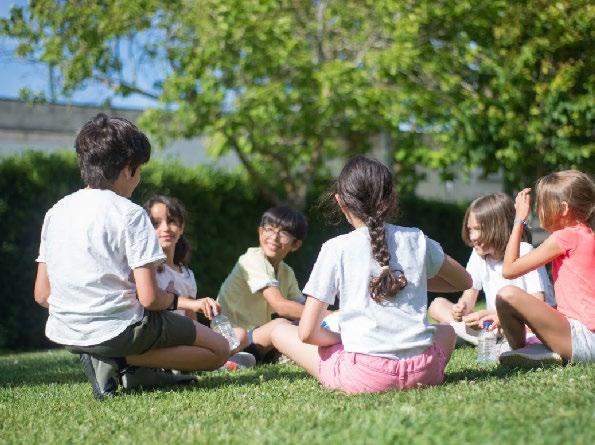
Goal 5: A County that celebrates, protects and promotes its rich culture and heritage, and is attractive to residents and visitors
+ A wealth of natural resources
+ The Gaeltacht areas, with strong language and cultural traditions
+ Rich history and heritage represented across Meath’s natural and built landscapes
+ Home to Brú na Boinne, a UNESCO Heritage Site
+ There are presently 3 confirmed and 28 proposed Natural Heritage Areas
+ The arts and cultural sector is vibrant and encompasses a broad range of activities that benefit the diverse population of the County
+ Meath County Council has prepared and implemented a programme of public realm plans
+ Strong library network (13 libraries)
+ Ongoing public realm work across the County delivered under the LECP 2016- 2021
The Tourism industry across the country was significantly impacted by Covid-19
Meath has a long tradition of agricultural and farming practices, which will require ongoing updating to align with international and national climate action objectives
46 Forests and woodlands have a
significant recreational and amenity value; however County Meath has one of the lowest ratios of planted area in the State
The equine industry is a valued asset and is hugely important to the economic performance of the County Public demand for additional accessible green spaces and public realm within walking distance
+ Fáilte Ireland objectives for the MidEast Region to 2024 include plans for developing the Boyne Navigation and Greenway, reimagined Boyne Valley Drive, and providing a range of business supports focused on meeting the needs of the tourism industry in the region
+ Delivery of Meath’s culture and creativity strategies 2023 to 2027
+ The national Creative Ireland programme (of which Meath is a part) has been extended to 2027
+ Programme of public realm planning
Over use or over capacity of some amenities and attractions
Goal 6: A County that welcomes, empowers and includes all communities
+ Significant population growth between 2016-2022 Population increase of 12.9% compared to State 7.6%
+ Growing ethnic and nationality diversity
+ Age Friendly Meath strategy and the Meath Age Friendly Alliance
+ Net migration accounted for an increase of approximately 14,921 persons according to preliminary Census 2022 results
+ Cost-competitive location – rents, average salaries etc.
+ More than 1800 refugees from Ukraine registered in the County as of December 2022
+ The Social Inclusion and Community Activation Programme, currently implemented at the County-level by the Meath Partnership.
High demand for community infrastructure, particularly newly developed areas and areas experiencing high population growth
Spatial concentrations of disadvantage and affluence
Housing supply and affordability, reflective of national challenges
Higher need for supports and services among particular groups, including lone parents, Travellers, people
with disabilities, and the long-term unemployed
Increased inclusion needed for those seeking asylum and refugees
Demand for increased integration among a culturally diverse population
Perception of need for more dedicated public spaces for teenagers to socialise safely
+ New pattern of urban-to-rural migration as a result of more flexible working and education opportunities
+ National and local policy developments on social inclusion
+ The delivery of Meath’s Housing Delivery Action Plan 2022-2026
Ongoing National housing crisis
Ongoing effects of conflicts and associated regular displacement of people versus the capacity and ability to respond
+ Fundamentally prosperous county
+ Strong record in attracting and retaining Foreign Direct Investment
+ Strong business services networks/ organisations, which actively support new business ventures and inward investing companies
+ High labour force participation and employment rates
+ Significant entrepreneurship support available
+ Boyne Valley Food Hub has grown and developed
+ In 2019, Meath had the second highest number of active enterprises (9,864) and persons engaged in active enterprises (44,690) in the region
+ Cost-competitive location
+ Meath has a lower vacancy rate (5.8%) than the State (7.8%),
+ Strong potential was identifi ed due to the high levels of educational attainment among the County’s residents.
Foreign Direct Investment (FDI), although growing, less developed than indigenous investment
Significant leakage of retail expenditure to other counties in the area of higher order comparison goods
Agriculture remains an important 48 economic activity in the County; however with a limited amount
of the labour force now working in agriculture, diversification and other employment opportunities are encouraged in order to sustain rural communities.
Localised pockets of higher deprivation, particularly Trim and Navan
Unemployment Blackspot in 1 ED: Kells Urban
Public perception of a need for increased local employment opportunities
+ Creating sustainable ‘live-work’ communities in a number of higher-tier settlements
+ Targeted approach to increase retail and commercial environment
+ Targeted approach to combating dereliction and vacancy rates
+ Encouraging town centre vibrancy with increased footfall from increase in remote working and public realm enhancement projects
Continuing impacts of Brexit
Ongoing effects of the war in Ukraine
Ongoing housing crisis resulting in emigration of skilled workforce
An evidence-based approach was taken in order to develop the LECP High-Level
Goals, and the sustainable Community Objectives (SCOs) and Sustainable Economic Development Objectives (SEDOs) associated with each goal.
Development was informed by the key findings from the policy context, the socio-economic profile, and the public consultation. The table below provides a summary of the High-Level Goals and the related SCOs/SEDOs. Further detail can be found in the followi ng chapter, 8.0 An
High-Level Goal Sustainable Community Objectives (SCOs) & Sustainable Economic Development Objectives (SEDOs)
SCO 1.1 To protect, conserve and enhance the natural environment
Goal 1: A sustainable, eco-friendly County that is committed to climate action
SCO 1.2 To educate and engage the public on climate and environmental issues and opportunities
SEDO 1.3 To promote the green economy
SEDO 1.4 Embed the Sustainable Development Goals in policy and practice.
SCO 2.1 Support connected and integrated public transport networks within and between urban and rural areas
Goal 2: A connected and accessible County
Goal 3: A healthy, thriving County
SCO 2.2 To encourage and support active transport (cycling and walking)
SEDO 2.3 To encourage and promote the transition to more sustainable transport patterns
SEDO 2.4 Support equitable access to the internet and digital skills
SCO 3.1 To improve health and wellbeing outcomes
SCO 3.2 To support the provision of adequate housing and shelter
SCO 3.3 To support proactive responses to emerging and emergency local needs
SCO 3.4 To increase perceptions and experience of community safety
SCO 3.5 To increase participation in recreation, sport and leisure
SCO 3.6 To Support the Provision of Community Health Supports
Goal 4: A County that works together to achieve the common good
Goal 5: A County that celebrates and promotes its rich culture and heritage and is attractive to residents and visitors
SCO 4.1 To stimulate and support interagency and collaborative approaches by the public sector
SCO 4.2 To support internal capacity for the LECP and LCDC
SCO 4.3 To encourage civic engagement including in local democratic processes of all residents and communities
SCO 4.4 To enable a joined up approach to community information delivery
SEDO 4.5 To create stronger networks among key agencies and enterprises
SCO 5.1 To further develop community arts and cultural actions
SCO 5.2 To preserve Meath’s heritage and enable appropriate access
SCO 5.3 To enhance the standing of Irish in and outside the Gaeltacht areas
SCO 5.4 To provide attractive, accessible public spaces and parks across the County
SEDO 5.5 To proactively promote the County’s attractions
SEDO 5.6 To enhance the public realm and promote Meath’s main town centers as retailing, visitor and employment centers
Goal 6: A County that welcomes, empowers, and includes all communities
SCO 6.1 To expand and strengthen equitable access to community infrastructure
SCO 6.2 To promote integration and inclusion of all communities of Meath
SCO 6.3 To reduce educational disadvantage
SEDO 6.4 To provide effective educational infrastructure provision
SEDO 6.5 Continue the collaborative and supportive response to navigating local planning process
Goal 7: A County that actively encourages and supports a growing economy and workforce
SCO 7.1 To increase levels of local employment and conditions for employability
SCO 7.2 Increase opportunities for remote working
SCO 7.3 Continue to promote an economic and employment development ethos throughout all departments and functions within Meath County Council, including among elected reps of the Council
SEDO 7.4 To provide effective infrastructure provision – sites and property solutions for employment generation
SEDO 7.5 To promote the economic opportunities and achievements in the County
Section 44 of the Local Government Reform Act (2014) includes a requirement that a Local Economic and Community Plan (LECP) shall be consistent with any Regional Spatial and Economic Strategy as well as the core strategy and the objectives of the development plan of the local authority concerned. Local authorities are required under the Local Government Reform Act to submit a draft LECP to the Regional Assembly for consideration and the Assembly is required to adopt a statement on the draft LECP.
The RSES is under pinned by 3 key principals i.e Healthy Placemaking, Climate Action and Economic Opportunity. 16 Regional Strategic Outcomes (RSOs) are cross referenced and aligned with the 3 key principles of the RSES and the UN Sustainable Development Goals.
These RSOs were considered during the development of Meath’s Framework LECP, both with regard to the development of the High-Level Goals, and the Sustainable Community Objectives (SCOs) and the
Sustainable Economic Development Objectives (SEDOs). The table below illustrates the alignment of the Meath Framework LECP to is aligned with the EMRA RSES.
Economic Opportunity
Global city region
Enhance regional
Improve education, skills and social inclusion
Goal 2: A connected County with joined-up and accessible communities
SCO 2.1 Support connected and integrated public transport networks within and between urban and rural areas
SEDO 2.4 Support equitable access to the internet and digital skills
Collaborative platform
Goal 6: A County that welcomes, empowers, and includes all communities
SCO 6.1 To expand and strengthen equitable access to community infrastructure
SCO 6.2 To promote integration and inclusion of all communities of Meath
SCO 6.3 To reduce educational disadvantage
Goal 4: A County that works together to achieve the common good
SEDO 6.4 To provide effective educational infrastructure provision
SEDO 6.5 Continue the Collaborative and Supportive response to navigating local planning process
SCO 4.1 To stimulate and support interagency and collaborative approaches by the public sector
SCO 4.2 To support internal capacity for the LECP and LCDC
SCO 4.4 To enable a joined up approach to community information delivery
SEDO 4.5 To create stronger networks among key agencies and enterprises
A strong economy supported by enterprise and innovation
Goal 7: A County that actively encourages and supports a growing economy and workforce
SCO 7.1 To increase levels of local employment and conditions for employability
SCO 7.2 Increase opportunities for remote working
SCO 7.3 Continue to promote an economic and employment development ethos throughout all departments and functions within Meath County Council, including among elected reps of the Council
SEDO 7.4 To provide effective infrastructure provision – sites and property solutions for employment generation
SEDO 7.5 To promote the economic opportunities and achievements in the County
Action
Biodiversity and natural heritage Goal 1: A sustainable, eco-friendly County that is committed to climate action
Build climate resilience
Sustainable management of water, waste and other
Integrated transport and land use
Enhanced green infrastructure
Support the transition to low-carbon and clean energy
Goal 2: A connected County with joined-up and accessible communities
SCO 1.2 To educate and engage the public on climate and environmental issues and opportunities
SEDO 1.3 To promote the green economy
SEDO 1.4 Embed the Sustainable Development Goals in policy and practice
Goal 3: A healthy, thriving County
Healthy communities
Healthy Placemaking
Rural communities
Creative places
Compact growth and urban regeneration
Sustainable settlement patterns
Goal 4: A County that works together to achieve the common good
Goal 5: A County that celebrates and promotes its rich culture and heritage and is attractive to residents and visitors
SCO 2.2 To encourage and support active transport (cycling and walking)
SEDO 2.3 To encourage and promote the transition to more sustainable transport patterns
SCO 3.1 To improve health and wellbeing outcomes
SCO 3.2 To support the provision of adequate housing and shelter
SCO 3.3 To support proactive responses to emerging and emergency local needs
SCO 3.4 To increase perceptions and experience of community safety
SCO 3.5 To increase participation in recreation, sport and leisure
SCO 3.6 To Support the Provision of Community Health Supports
SCO 4.3 To encourage civic engagement including in local democratic processes of all residents and communities
SCO 5.1 To further develop community arts and cultural actions
SCO 5.2 To preserve Meath’s heritage and enable appropriate access
SCO 5.3 To enhance the standing of Irish in and outside the Gaeltacht areas
SCO 5.4 To provide attractive, accessible public spaces and parks across the County
SEDO 5.5 To proactively promote the County’s attractions
SEDO 5.6 To enhance the public realm and promote Meath’s main town centers as retailing, visitor and employment centers
High-Level Goal
Sustainable Community Objectives (SCOs) & Sustainable Economic Development Objectives (SEDOs)
SCO 1.1 To protect, conserve and enhance the natural environment
Goal 1: A sustainable, eco-friendly County that is committed to climate action
SCO 1.2 To educate and engage the public on climate and environmental issues and opportunities
SEDO 1.3 To promote the green economy
SEDO 1.4 Embed the Sustainable Development Goals in policy and practice.
SCO 2.1 Support connected and integrated public transport networks within and between urban and rural areas
SCO 2.2 To encourage and support active transport (cycling and walking)
Goal 2: A connected and accessible County
SEDO 2.3 To encourage and promote the transition to more sustainable transport patterns
Alignment with Meath County Development Plan 2021-2027
• CS OBJ 13 Support the implementation of the National Climate Change Strategy and the National Climate Change Adaption Framework Building Resilience to Climate Change 2012 through the County Development Plan and through the preparation of a Climate Change Adaptation Plan in conjunction with all relevant stakeholders.
• ER OBJ 59 To identify and map green infrastructure assets and sites of local biodiversity value over the lifetime of the Plan.
• CS OBJ 13 Support the implementation of the National Climate Change Strategy and the National Climate Change Adaption Framework Building Resilience to Climate Change 2012 through the County Development Plan and through the preparation of a Climate Change Adaptation Plan in conjunction with all relevant stakeholders.
• HER POL 55 To recognise the economic, social, environmental and physical value of Green Infrastructure.
• CS OBJ 20 Ensure compliance with Climate Change requirements
• MOV POL 1 To support and facilitate the integration of land use with transportation infrastructure, through the development of sustainable compact settlements which are well served by publi c transport, in line with the guiding principles outlined in RPO
8.1 of the EMRA RSES 2019-2031."
• SOC POL 3 To ensure that, where practicable, community, recreational and open space facilities are clustered, with the community facilities being located in local centres or combined with school facilities, as appropriate. Community facilities should be located close to or within walking distance of housing, accessible to all sectors of the community and facilitate multi - use functions through their design and layout.
• MOV POL 17 To identify and seek to implement a strategic, coherent and high-quality cycle and walking network across the County that is integrated with public transport and interconnected with cultural, recreational, retail, educational and employment destinations and attractions. To ensure that, where practicable, community, recreational and open space facilities are clustered, with the community facilities being located in local centres or combined with school facilities, as appropriate. Community facilities should be located close to or within walking distance of housing, accessible to all sectors of the community and facilitate multi -use functions through their design and layout."
SEDO 2.4 Support equitable access to the internet and digital skills
• SOC POL 16 To ensure the provision of preschool, primary and post primary education facilities in conjunction with the planning and development of residential areas, maximises opportunities for use of walking, cycling and use of public transport.
• RPO 8.7 To promote the use of mobility management and travel plans to bring about behaviour change and more sustainable transport use.
• INF OBJ 51 To support the delivery and implementation of the National Broadband Plan
• INF POL 54 To facilitate the delivery of a high capacity Information and Communications Technology (ICT) infrastructure and broadband network and digital broadcasting throughout the County
• SOC POL 29 To support and co-operate with promoters or operators of public and private health care facilities by facilitating and encouraging the provision of improved health care facili ties in appropriate locations..
Goal 3: A healthy, thriving County
SCO 3.1 To improve health and wellbeing outcomes
SCO 3.2 To support the provision of adequate housing and shelter
SCO 3.3 To support proactive responses to emerging and emergency local needs
SCO 3.4 To increase perceptions and experience of community safety
SCO 3.5 To increase participation in recreation, sport and leisure
SCO 3.6 To Support the Provision of Community Health Supports
• SOC POL 26 To ensure that adequate lands and services are available for the improvement, establishment and expansion of health services.
• CS OBJ 2 To ensure that sufficient zoned lands are available to satisfy the housing requirements of the County in designated settlements over the lifetime of the Plan.
• CS OBJ 12 To ensure that all settlements, in as far as practicable, develop in a self-sufficient manner with population growth occurring in tandem with the provision of physical and social infrastructure.
• SOC POL 12 To support the implementation of the Meath Joint Policing Strategy, 2015-2020 (or its replacement) in consultation with the relevant agencies and authorities.
• SOC POL 2 To support the provision and distribution of a range of community infrastructure facilities in accordance with the Settlement and Core Strategies to meet the needs of the County’s population in conjunction with other statutory, voluntary, private sector and community groups.
• CS OBJ 6 To strengthen the social and economic structure of rural towns and villages by supporting the re-use of existing buildings and the regeneration of under-utilised buildings and lands.
• SOC POL 2 To support the provision and distribution of a range of community infrastructure facilities in accordance with the Settlement and Core Strategies to meet the needs of the County’s population in conjunction with other statutory, voluntary, private sector and community groups.
Goal 4: A County that works together to achieve the common good
SCO 4.1 To stimulate and support interagency and collaborative approaches by the public sector
SCO 4.2 To support internal capacity for the LECP and LCDC
SCO 4.3 To encourage civic engagement including in local democratic processes of all residents and communities
SCO 4.4 To enable a joined up approach to community information delivery
SEDO 4.5 To create stronger networks among key agencies and enterprises
Goal 5: A County that celebrates and promotes its rich culture and heritage and is attractive to residents and visitors
SCO 5.1 To further develop community arts and cultural actions
SCO 5.2 To preserve Meath’s heritage and enable appropriate access
SCO 5.3 To enhance the standing of Irish in and outside the Gaeltacht areas
• CS OBJ 17 To work closely with government departments and agencies to assist in the delivery of critical infrastructure that would facilitate the economic growth of the county with particular reference to the development of the rail to Navan.
• SOC POL 1 To promote and facilitate the delivery of the objectives and actions set out in the Meath Local Economic and Community Plan 2016-2021. (or any subsequent replacement).
• ED OBJ 3 To continue to work with key state agencies and other stakeholders to develop opportunities for employment creation in the County.
• SOC POL 2 To support the provision and distribution of a range of community infrastructure facilities in accordance with the Settlement and Core Strategies to meet the needs of the County’s population in conjunction with other statutory, voluntary, private sector and community groups.
• HER POL 54 To protect the archaeological heritage, rural character, setting and amenity of the Tara landscape and Loughcrew and Slieve na Calliagh Hills.
• SOC POL 2 To support the provision and distribution of a range of community infrastructure facilities in accordance with the Settlement and Core Strategies to meet the needs of the County’s population in conjunction with other statutory, voluntary, private sector and community groups.
• HER POL 54 To protect the archaeological heritage, rural character, setting and amenity of the Tara landscape and Loughcrew and Slieve na Calliagh Hills.
• SOC POL 32 To encourage and support local sports, community groups and other groups in the provision and development of outdoor and indoor sporting and community facilities.
Goal 6: A County that welcomes, empowers, and includes all communities
SCO 5.4 To provide attractive, accessible public spaces and parks across the County
• HER POL 1 To protect sites, monuments, places, areas or objects of the following categories: Sites and monuments included in the Sites and Monuments Record as maintained by the National Monuments Service of the Department of Culture, Heritage and the Gaeltacht; Monuments and places included in the Record of Monuments and Places as established under the National Monuments Acts; Historic monuments and archaeological areas included in the Register of Historic Monuments as established under the National Monuments Acts; National monuments subject to Preservation Orders under the National Monuments Acts and national monuments which are in the ownership or guardianship of the Minister for Culture, Heritage and the Gaeltacht or a local authority; Archaeological objects within the meaning of the National Monuments Acts; and Wrecks protected under the National Monuments Acts or otherwise included in the Shipwreck Inventory maintained by the National Monuments Service of the Department of Culture, Heritage and the Gaeltacht.
SEDO 5.5 To proactively promote the County’s attractions
SEDO 5.6 To enhance the public realm and promote Meath’s main town centers as retailing, visitor and employment centers
• CS OBJ 2 To ensure that sufficient zoned lands are available to satisfy the housing requirements of the County in designated settlements over the lifetime of the Plan.
• CS OBJ 2 To ensure that sufficient zoned lands are available to satisfy the housing requirements of the County in designated settlements over the lifetime of the Plan.
• ED OBJ 3 To continue to work with key state agencies and other stakeholders to develop opportunities for employment creation in the County.
SCO 6.1 To expand and strengthen equitable access to community infrastructure
SCO 6.2 To promote integration and inclusion of all communities of Meath
SCO 6.3 To reduce educational disadvantage
SEDO 6.4 To provide effective educational infrastructure provision
SEDO 6.5 Continue the Collaborative and Supportive response to navigating local planning process
SCO 7.1 To increase levels of local employment and conditions for employability
SCO 7.2 Increase opportunities for remote working
Goal 7: A County that actively encourages and supports a growing economy and workforce
SCO 7.3 Continue to promote an economic and employment development ethos throughout all departments and functions within Meath County Council, including among elected reps of the Council
SEDO 7.4 To provide effective infrastructure provision – sites and property solutions for employment generation
SEDO 7.5 To promote the economic opportunities and achievements in the County
• CS OBJ 1 To secure the implementation of the Core Strategy and Settlement Strategy, in so far as practicable, by directing growth towards designated settlements, subject to the availability of infrastructure and services.
• SOC POL 7 To promote and encourage social inclusion through universal access to services and facilities and to encourage the upgrade of community facilities."
• SOC POL 15 To facilitate the development of preschool, primary, post primary, third level, outreach, research, adult and further educational facilities to meet the educational needs of the citizens of the County."
• SOC POL 2 To support the provision and distribution of a range of community infrastructure facilities in accordance with the Settlement and Core Strategies to meet the needs of the County’s population in conjunction with other statutory, voluntary, private sector and community groups.
• SOC POL 4 To ensure the delivery of community facilities commensurate with the needs of the resident population is done in tandem with new residential developments in the interests of the proper planning and sustainable development of the area, and to assist in the delivery of such facilities."
• CS OBJ 14 Support the economic growth of Meath as set in the Regional Spatial and Economic Strategy
• ED OBJ 4 To identify suitable locations and support the provision of co-working facilities, digital hubs/eHubs and eWorking centres throughout the County that function as outreach hubs for city-based employers and promote flexible working arrangements.
• CS OBJ 15: To continue to promote economic development of the Dublin-Belfast Economic Corridor.
• CS OBJ 4 To achieve more compact growth by promoting the development of infill and brownfield/ regeneration sites and the redevelopment of underutilised land within and close to the existing built-up footprint of existing settlements in preference to edge of centre locations.
• CS OBJ 16 To support the creation of ‘live work’ communities, in which employment and residential accommodation are located in close proximity to each other and strategic multi-modal transport corridors, and to reduce long distance
7.1 Goal 1: A sustainable, eco-friendly County that is committed to climate action

Meath has a varied landscape and is rich in natural resources. The County is committed to preservation and conservation, and has several designated Special Protection Areas, Special Areas of Conservation, and Natural Heritage Areas. At the county-level, Meath has developed and implemented both biodiversity and climate action plans, and several towns have developed local biodiversity action plans. Public consultation indicated that there are many community-led environmental initiatives, and participants noted that they would welcome increased investment and coordination from the Local Authority. Similarly, participants representing the business sector were eager to adopt green practices, and expressed an interest in education and advice on how to engage in climate action. The majority of homes across Meath are heated with oil, and the county was the 6th highest consumer of residential metered electricity in 2021. Analysis of public
consultation data revealed that there is an appetite for increasing Meath’s use of renewable energy sources. Participants also noted the opportunity to build on and increase sustainable agricultural and farming practices.
Both existing policy and initiatives and public consultation suggested that environmental challenges are a critical issue in Meath, and must be considered across all future plans, strategies and developments. As such the objectives below aim to ensure that Meath is a sustainable County that is committed to climate action.
This High-Level Goal and associated objectives support the Key Principle of Climate Action outlined in the RSES, including Regional Strategic Objectives (RSOs) of the RSES in relation to building climate resilience (RSO 8), supporting the transition to low carbon and clean energy (RSO 9), enhancing green infrastructure (RSO 10) and biodiversity and natural heritage (RSO 11). In addition, the goal supports RPO 3.7 in relation to environmental and sustainability considerations for new development proposals.

Sustainable Community Objectives (SCO's) & Sustainable Economic Development Objectives (SEDO's)
SCO

To protect, conserve and enhance the natural environment

To educate and engage the public
SCO 1.2 on climate and environmental issues and opportunities

SCO 1.3 To promote the green economy

SCO
To embed the Sustainable Development Goals in policy and practice


OBJECTIVE SCO 1.1 To protect, conserve and enhance the natural environment
Action 1.1.1
Encourage and promote the move towards nearzero-energy in council existing buildings in line with the Meath Climate action strategy.
Action 1.1.2 Promote increased energy efficiency in the council housing stock including retrofitting (10 year programme with annual targets).
MCC Facilities MCC Environment, MCC Climate Action ST (2024) No. of zero-energy implementations across council buildings and percentage of increase on current figures.
MCC Housing Department of Housing, Local Government and Heritage LT – but annual increases (2024) No. of energy efficient houses in council housing stock and percentage of increase on current figures.
Action 1.1.3 Develop Local Authority Renewable Energy Strategy (LARES) for County Meath, in line with SEAI guidance MCC Environment MCC Climate Action ST for strategy – MT for implemented actions (2024) LARES strategy complete and actions being implemented.
Action 1.1.4 Support the development and delivery of community energy projects and collaborate with Sustainable Energy Community groups to promote the benefits of community projects to other communities.
Action 1.1.5 Enhance the capacity of Meath County Council to lead on and drive environmental sustainability policies and programmes for the County.
Action 1.1.6 Engage with the agricultural community to understand how the local council can support resilience efforts and sustainable farming practices.
Action 1.1.7 Liaise and collaborate with relevant agencies to improve the condition of peatland to reduce emissions.
MCC Climate Action Public Participation Network (PPN), Sustainabl e Energy Communities ST (2024) No. of community sustainable energy projects and percentage increase on current figures.
Department of the Environment, Climate and Communications
MCC Climate Action Irish Farmer’s Association; Local Authority Waters Programme; Teagasc
No. of environmental sustainability policies and programmes in place and strength of policies
No. of meetings held and practices developed and adopted.
(2024)
of Meetings held and actions arising Action 1.1.8
Maintain a database to facilitate planning decisions, including species records from council surveys and other available sources (IWeBS etc), sites of county importance and past Environmental Impact Assessments to better facilitate judgement on likely individual and cumulative impact of proposals. Ensure that the database is compatible with and is linked with the National Biodiversity Data Centre databases.
MCC Climate ActionBiodiversity Officer MCC Planning
and regular maintenance of database.
Action 1.1.9
To support and enable activity to protect, conserve and enhance the county’s natural heritage and biodiversity.
MCC Climate Action MCC Heritage Officer and MCC Biodiversity Officer
No. of activities implemented to protect, conserve and enhance the county’s natural heritage and biodiversity.
To educate and engage the public on climate and environmental issues and opportunities
Action 1.2.1
Continue to make Environmental & Sustainability
Level 4 & 5 Courses available in Navan, Kells, Athboy, Trim Louth & Meath Education and Training Board (LMETB) Employees & Department of Social Protection Clients Parttime employed
Action 1.2.2 Continued education provision for environmental and sustainability focused educational programmes
Action 1.2.3 Promote the use of the library facilities as locations for Climate Action Groups & Community Organisations access to meeting facilities and events programming and space.
Action 1.2.4 Educate and engage communities on Climate Action through the provision of socially engaged arts programmes focusing on sustainability, the environment and climate action.
1.2.5 Create a sustainable clubs initiative to engage GAA/ Soccer/Rugby Clubs to implement reforms eg. Energy conservation, EU Charging, Solar Panels, ICIT recycling Schemes etc.
Action 1.2.6 To create greater awareness of and engagement with environmental issues and activities at community level.
+ Volunteer Groups and Agencies, PPN
1.3.1 Investigate the feasibility to create a Digital Twin Pilot town to enable the modelling on how environmental improvements, street remodelling could impact environmental impact/ Street utilization visual aspect etc. Broadband Offcer BBO, Climate Action, Town Centre First, Urbact
Action 1.3.2 Encourage and promote projects that will contribute positively and grow the circular and bio-economy to promote sustainable rural and urban low carbon economic development.
Action 1.3.3
Showcase businesses in County Meath that are directly benefiting from and/or promoting the Green Economy. Showcase and support businesses that embrace sustainability and climate friendly practices in their systems and processes.
MCC Climate Action LEADER, Local Enterprise Office (LEO), Enterprise Ireland ST (2024) No. of projects undertaken
LEO MCC climate action, LEADER, MCC Planning & Economic Development ST (2024) No. of and methods of showcasing noted
OBJECTIVE 1.4 SEDO Embed the Sustainable Development Goals in policy and practice.
Action 1.4.1 Link the use of the SDG's to grant programmes with the objective of achieving greater SDG Knowledge. MCC, PPN Community Groups ST (2024) SDGs successfully linked with grant programmes. Grant Programmes utilising SDGs as part of their awarding criteria.

Meath is well-connected by road to other counties across Ireland, and is served by several National Roads. More than half of people in Meath lived 5km or closer to a primary or secondary National Road.
Meath is also heavily dependent on the road system for travel within the County. A unique element of Meath’s employment is the high commuter rate, with more than half of workers commuting to a job outside the County.
There is particularly high cardependence, and the rates of people commuting to work by public transportation or active transport (on foot or bicycle) were lower than State levels. Consultation indicated that participants would like to see an increase in public transportation, including buses and trains, and an increase in pedestrian and cycle infrastructure. This preference aligns with Meath’s County Development Plan, which identified objectives related to encouraging and facilitating increased active transport and public transport. According to public consultation, intra-county connectivity was of particular importance, with participants noting that proximity and limited transport options were barriers to accessing supports, services, and recreational activities within the County. Accordingly, the objectives below aim to achieve
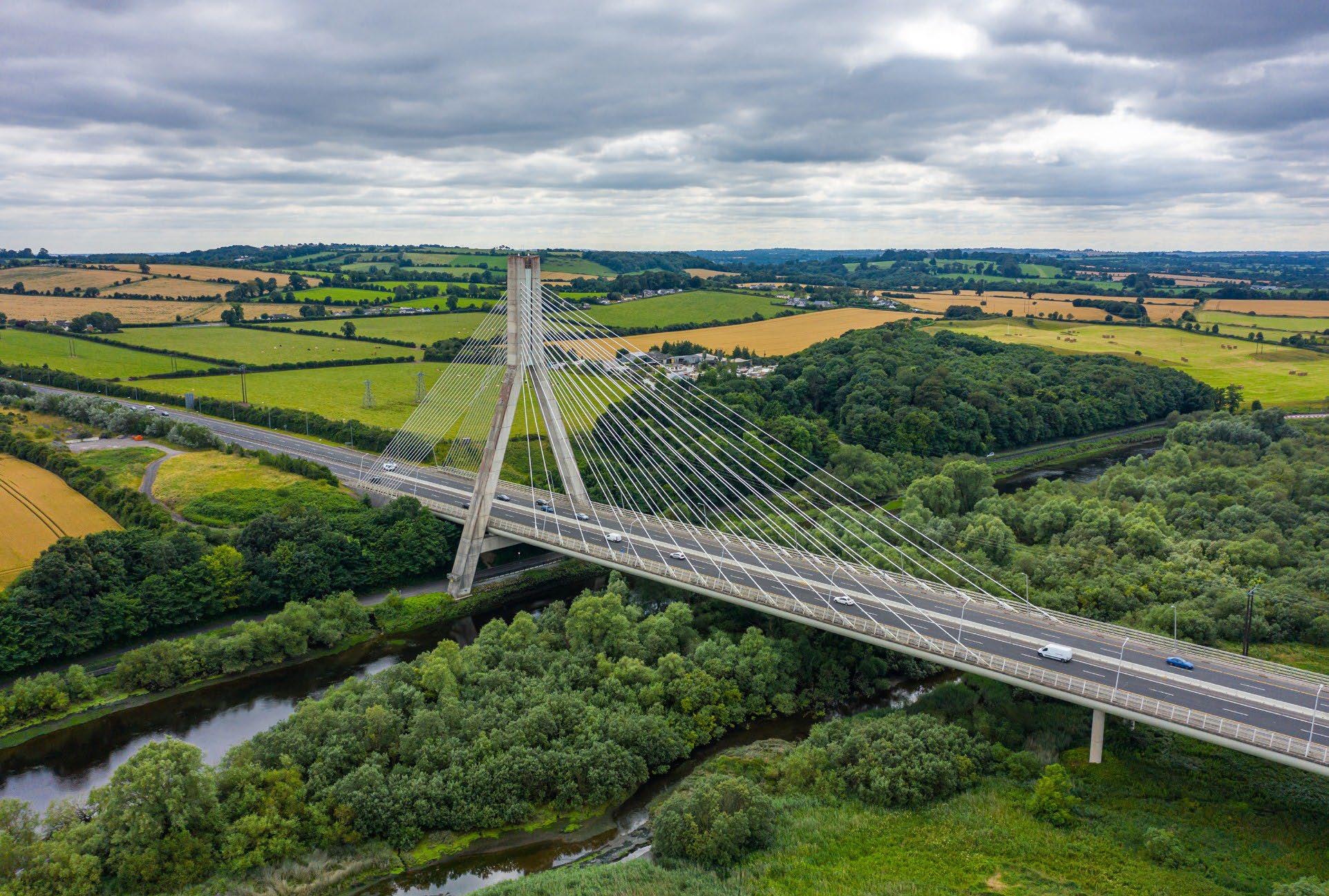
the goal of making Meath a connected County with joined-up and accessible communities.
These objectives support the Key Principles of Climate Action and Economic Opportunity outlined in the RSES, including RSOs in relation to Healthy Communities (RSO 4), Integrated Transport and Land Use (RSO 6), and Enhanced Strategic Connectivity (RSO 15). In addition, the goals support RPOs including RPO 9.10 in relation to encouraging sustainable travel options (walking and cycling), RPO 4.57 in relation to tourism and RPO 8.1 in relation to the integration of transport and land
use planning. The objectives listed above also support the Guiding Principles for the Integration of Land Use and Transport as outlined in the RSES.

Sustainable Community Objectives (SCO's) & Sustainable Economic Development Objectives (SEDO's)

Support connected and integrated public SCO 2.1 transport networks within and between urban and rural areas

SCO

To encourage and support active transport (cycling and walking)

SCO

To encourage and promote the transition to more sustainable transport patterns

SCO
Support equitable access to the internet and digital skills.

OBJECTIVE SCO 2.1 Support connected and integrated public transport networks within and between urban and rural areas
Action 2.1.1 Expand shared and community transport initiatives.
Action 2.1.2 Identify, highlight, and address the issues relation to poor public transport and significantly improve the infrastructure and accessibility to the public.
Action 2.1.3
Action 2.1.4
Support the implementation of The Greater Dublin Area Transport Strategy in Meath, particularly Measure RAIL4 – Navan Rail Line. While the NTA's anticipated start date is 2031-2036, there may be an opportunity to investigate predevelopment surveys and other supporting actions.
Support the delivery of road infrastructure to release strategic residential and employment lands for sustainable development and to improve connectivity and the efficient movement of people and services in the town.
MCC Transportation/ National Transport Authority (NTA) Meath Flexibus, transport companies and relevant others
MCC Transportation/ NTA MCC Planning & Economic Development, Meath Flexibus, transport companies and relevant others
- LT No of issues identified are addressed, with outcome of improved infrastructure after public consultation
MCC Transportation / NTA MCC Planning & Economic Development LT, ongoing Design team appointed, Pre-development Surveys investigated and discussed, planning documented
Transportation DoT, landowners, MCC Planning & Economic Development
routes/increase on current number Action 2.1.5 Complete the Navan Bus Interchange in
Road, Navan.
Action 2.1.7 Collaborate with the NTA's Park and Ride office to develop and obtain statutory approval for a 350 space Park and Ride south of Ashbourne.
2.2.1
walkability studies to increase awareness and access to local services for older people.
Action 2.2.2 Increase number of age-friendly parking spaces, identifying local needs, etc. Age-friendly Meath ST (2024) No. of spaces delivered
Action 2.2.3
Action 2.2.4
Support the extension of the Boyne Greenway to include Navan to promote sustainable transport choices and as a recreation asset for the town.
Construct a 30km Greenway between Navan and Kingscourt along the disused railway line.
Action 2.2.5 Conduct trials of bike rental schemes in Navan and Ashbourne.
MCC Transportation Consult with Transportation, MCC Planning & Economic Development
MCC Transportation Transport Infrastructure Ireland (TII), Department of Rural and Community Development (DRCD), CIÉ
Action 2.2.6 Obtain statutory approval for a greenway along the River Boyne between Navan and Oldbridge House. MCC Transportation TII, Department of Transport (DOT), Office of Public Works (OPW), An Taisce, National Parks and Wildlife Service (NPWS), Department of Tourism, Culture, Arts, Gaeltacht, Sport and Media (DTCAGSM), MCC Planning & Economic Development
Action 2.2.7 Complete the construction of pedestrian and cycling improvement scheme on R125 and R155 in Ratoath.
2.2.10 To
schemes in Navan on the Trim Road, Circular Road and R147 (Martha's Bridge to Circular Road).
Greenway extended
2023 ST (2024) Construction complete and Greenway open
Action 2.4.1 Deliver workshops/ briefings on digital tools & supports through community groups including AgeFriendly, Cultúr, Home Security, Cyber Security.
MCC Broadband Officer PPN, Age Friendly Alliance Medium term No. workshops/briefings delivered; No. attendees
Action 2.4.2 Review and Support the implementation of the Meath Digital Strategy.
Action 2.4.3 Develop initiatives to reduce digital poverty and promote comprehensive technology access.
Action 2.4.4 Develop a Hubs Strategy to foster the development of new hubs and the progression of existing hubs for the community & remote work.
BBO/HIS/Broadband Officer Steering Committee, MCC MT Strategy launched and delivery on target as per strategy
BBO MCC Planning, Transportation, National Broadband Ireland (NBI), Navan Traveller Workshop, PPN LT - Ongoing Initiatives developed and delivered; strategy implemented
Meath Enterprise MCC Broadband Officer Short Term, ST (2024) Hubs Strategy developed; implementation of strategy
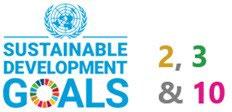
Meath has a young and relatively healthy population that is growing fast. While analysis of data revealed that there is good residential proximity to health services, public consultation indicated that GPs are often full, and there are long waiting lists for physical and mental health services. Meath has a number of initiatives and strategies aimed at improving and supporting health and wellbeing across the County, including Healthy Meath Strategy 2023-2025. The Meath Sports Partnership facilitates programmes and events with the aim of
getting “more people more active more often.” Public consultation suggested that participants would like to see a reduction of barriers to accessing physical and mental health services, including cost, proximity, and stigma. Participants were also hopeful that there would be increased access to fitness classes, events, and gym memberships, and noted that physical and mental health are inseparable in the pursuit of wellbeing.
Analysis of the evidence-base suggested that Meath is a relatively safe county, and that the number of recorded crime offences fell between 2019-2022. The county is home to the Meath Joint Policing Committee (JPC) comprised of members of Meath County Council and An Garda Síochána. The JPC has developed and is continuing to implement the Meath Joint Policing Committee Strategic Plan 2021-2026. Safety was

a key priority for participants during the public consultation process. Consultation indicated that participants felt that public safety could be enhanced by increasing visible garda presence, public lighting, public realm maintenance, increased alcohol and substance misuse supports, and continuing efforts to reduce antisocial activity.
To build on these strengths, address the challenges and create future opportunities, the objectives and actions are set out below, aimed at achieving the overall goal of a safe, healthy and thriving County.
These objectives support the Key Principle of Healthy Placemaking outlined in the RSES, including the RSO in relation to Healthy Communities (RSO 4). They also demonstrate consistency with RPOs such as RPO 9.13 in relation to new social infrastructure developments being accessible and inclusive for a range of users and RPO 9.16 in relation to public health policy supports. The objectives listed above also support the Guiding Principles for the creation of healthy and attractive spaces detailed in Section 9.4 of the RSES.

SCO 3.1 To improve health and wellbeing outcomes

SCO
SCO 3.3

To support the provision of adequate housing and shelter

To support proactive responses to emerging and emergency local needs

SCO
SCO 3.5

To support proactive responses to emerging and emergency local needs

3.6
To increase participation in recreation, sport and leisure

To support the provision of community health supports
OBJECTIVE SCO 3.1 To improve health and wellbeing outcomes
Action 3.1.1
Action 3.1.2
Support an increased focus on early intervention to support young children.
Children and Young People’s Services Committees (CYPSC)
Louth Meath Education and Training Board (LMETB) to run community health and wellbeing courses and review the enrolement requirements for these courses.
Action 3.1.3
Action 3.1.4
Health Services Executive (HSE), Tusla, Meath Couty Childcare Committee (MCCC), An Garda Síochána (AGS)
Short Term (2024) Focus points identified and implemented.
LMETB PPN (for promotion) Short Term (2024) Enrollment requirements updated and courses completed
Support the development of Park Walks/Runs (Particularly mentioned Blackwater). Meath Local Sports Partnership (MLSP) local communities, PPN Short Term (2024) No. of park walks/Runs developed
Create and distribute information and workshops to promote positive youth mental health.
Jigsaw Consult with Jigsaw Short Term (2024) Level of information distributed and no. of workshops developed and delivered
Action 3.1.5 Develop a positive mental health coaching programme to raise awareness of issues and coping strategies.
Action 3.1.6
Support the development of a ‘Meath Wellbeing Network’ to raise awareness and provide information on positive mental health supports available in County
Action 3.1.7 Support and promote positive mental health programmes, workshops and events to raise awareness and build community resilience for target groups.
Action 3.1.8 Support the implementation of Arts and Health programmes with a focus on health and wellbeing.
Jigsaw EAA, Consult with Jigsaw Short Term (2024) Coaching Programme developed and delivered.
Healthy Ireland (HI) Co-ordinator SOSAD Short Term (2024) Network established
HI Co-ordinator HSE Short Term (2024) No. programmes, workshops or events delivered; Target groups engaged
HI Co-ordinator Meath Arts Office, Libraries Short Term (2024) No. arts and health programmes delievered
Action 3.1.9 Support the implementation of updated Healthy Meath Plan 2023-2025. MCC HSE/PPN/Jigsaw/Foroige Short Term (2024) No. Healthy Meath actions implemented
OBJECTIVE SCO 3.2 To support the provision of adequate housing and shelter
Action 3.2.1
Action 3.2.2
Action 3.2.3
Progress the Development of the new refuge for women and children with experience of Domestic, Sexual & Gender Based Violence Services.
Meath Women's Refuge and Support Services
Explore the feasibility of provision of step Down Accommodation for women and children with experience of Domestic, Sexual & Gender Based Violence Services.
Increase the provision of social housing and affordable housing in line with Housing Delivery Action Plan.
MCC Housing, Department of Housing, Local Government and Heritage (DHLGH), HSE
Medium Term Committee appointed; stages of development completed
Action 3.2.4
Action 3.2.5
Action 3.2.6
Continue to meet the needs of those experiencing or at risk of homelessness through provision of additional capacity; meeting annual Housing First targets and HAP Placefinder; review current Mid East Region Homeless Action Plan and adopt its successor in 2024
Continue to work to meet the housing targets set out in the Meath Strategy For Housing Disabled Persons
Continue work to meet housing targets set out in the Meath Traveller Accommodation plan.
Action 3.2.7 Encourage the provision of accommodation for right-sizing within the public and private sector
Action 3.2.8
Identify vacant sites with potential for development as housing schemes (social and private) including the use of Compulsory Purchase Order where appropriate.
Action 3.2.9 Promote the Slainte Care Healthy Age Friendly Homes Programme rollout in Meath.
Meath Women's Refuge and Support Services
Meath County Council Housing, Approved Housing Bodies, DHLGH
Medium Term - LT Review completed; report issued
MCC Housing DHLGH; Approved Housing Bodies; Local Government Management Agency (LGMA) Housing Delivery Coordination office, HSE Medium/Long term No. social / affordable housing units delivered
MCC Housing Settlement Team Regional partners; Housing Action Team; Service Providers
Short/Medium Term (2024)
See Housing First targets; Mid-East Region Homeless Action Plan objectives
MCC Housing Housing Disability Steering Group, HSE
Term (2024)
accessible housing units delivered
MCC Housing Local Traveller Accommodation Committee, HSE Short/Medium Term (2024) No. Traveller – specific accommodation units delivered
MCC MCC Planning, AF Tech Advisor Short/Medium Term (2024) Principles adopted in policy
MCC Town Centre First Team, MCC Planning & Economic Development Town teams, MCC Housing Medium Term No. sites identified; no. sites progressed to development
AFI Shared Service HSE, AFA, OPC, Elected Members Medium/Long Term Awareness campaign held; Slainte Care Healthy Age Friendly Homes targets met
OBJECTIVE SCO 3.3 To support proactive responses to emerging and emergency local needs
Action 3.3.1 Resource and roll out a community mobilisation project to educate people on Domestic, Sexual & Gender Based Violence Services.
Meath Women’s Refuge and Support Services (MWRSS)
MWRSS, Stakeholder Management group includes C+V Sector, MCC, Dept Justice
(2024)
Action 3.3.2 Support development of a regional hospital to serve the north east of the country. HSE, Department of Health MCC Planning & Economic Development Long term
Action 3.3.3 Promote and support the development of ECC programmes and enhanced Primary Care
Centres to support communities to avoid hospital admission where possible
OBJECTIVE SCO 3.4 To increase perceptions and experience of community safety
Action 3.4.1 Increasing awareness for need of diversity in Joint Policing Committee (JPC) Membership.
Action 3.4.2
Develop a protocol in response to critical incidents involving young people. Meath CYPSC Tusla; MCC; HSE; An Garda Síochána (AGS)
Action 3.4.3 Support the roll out of the 'Use Your Brain Not Your Fist’ campaign, incorporating a code of conduct, aiming to reduce verbal and physical abuse on pitches.
3.4.4 Implement relevant actions set out in the Drogheda Implementation Plan particularly in the East Meath Area
OBJECTIVE SCO 3.5 To increase participation in recreation, sport and leisure
of people attending/engaged with education programmes
OBJECTIVE SCO 3.6 To Support the Provision of Community Health Supports
Action 3.6.1 Aim to improve knowledge on the importance of healthy lifestyle habits and provide screening for reducing Non-Communicable Disease (NCD) risk amongst Healthy Meath target groups.
Action 3.6.2 Utilise a partnership approach to increase awareness and provide information and practical supports to Healthy Meath target groups.
Action 3.6.3 Improve and maintain the positive mental health of individuals within the Healthy Ireland target groups by focusing on the protective factors for enhancing wellbeing and quality of life.
Action 3.6.4 Deliver a targeted programme for the Traveller Community health supports.
Action 3.6.5 Deliver a multifaceted targeted programme for people living in disadvantaged communities to improve healthy lifestyle habits.
Action 3.6.6
Healthy Ireland Coordinator HSE, Youthwork Ireland Meath, PPN
Healthy Ireland Co-ordinator HSE, Youthwork Ireland Meath, PPN
-
(2024) Improved health indicators in Healthy Meath target groups
Term - ST No. of partnerships established
Healthy Ireland Co-ordinator HSE, Youthwork Ireland Meath, PPN Medium/Long Term Improved mental health indicators in target groups
Healthy Ireland Coordinator HSE, Youthwork Ireland Meath, PPN Medium Term Programme developed and no. of Traveller communities engaged
Healthy Ireland Coordinator HSE, Youthwork Ireland Meath, PPN
Medium Term No. of communities represented
Continued promotion of the 'Not Around Us' campaign throughout the county. MCC Community sporting groups, PPN ST - ongoing No.
Action 3.6.7 Support the implementation of the North Eastern Drug and Alcohol Task Force (NERDATF) Strategy
Action 3.6.8 Aim to improve the information on the services available for U18's who are experiencing difficulties in relation to their drug and/or alcohol use and on support services available to service users and families.
Action 3.6.11 Support and facilitate the delivery of Meath’s Healthy Ireland Strategy 2023
of
7.4 Goal 4: A County that works together to achieve the common good

Meath has a robust network of service providers, with over 450 organisations and groups registered as members of the Public Participation Network. There are several examples of collaborative approaches to economic and community development, including the Local Community Development Committee (with 51% non-statutory and 49% statutory membership), the Meath Joint Poli cing Committee (a partnership between Meath County Council, community representatives, and An Garda Síochána).
Public consultation indicated that both organisations and community members would welcome the continuation and growth of collaborative approaches to development. Participants representing the business sector suggested increased networking opportunities for those involved in local businesses, while community members noted that clear communication from service providers about available supports and services was important. Service providers in turn indicated that the facilitation of clear

communication from the local authority to their organisations, and increased networking between themselves and other statutory and volunteer agencies would improve delivery of services. As such, the objectives below are set out with the aim of achieving the overall goal of being a County that works together.
These objectives support the Key Principles of Economic Opportunity and Healthy Placemaking outlined in the
RSES, including the RSO in relation to Collaborative Platform (RSO 16). They also demonstrate consistency with a range of RPOs including RPOs 6.25 and 6.26 in relation to collaboration with educational providers and industry and research agencies on skills and innovation advances.


SCO

To stimulate and support interagency and collaborative approaches by the public t

SCO
To support internal capacity for the LECP and LCDC


SCO
To encourage civic engagement including in local democratic processes of all residents and communities

SCO

To enable a joined up approach to community information delivery


SEDO
To create stronger networks among key agencies and enterprises

OBJECTIVE SCO 4.1 To stimulate and support interagency and collaborative approaches by the public sector
Action 4.1.1
Continue to engage with Louth County Council and Kildare County Council to develop and implement the Drogheda Joint Urban Area Plan and the Maynooth Joint Urban Area Plan
& Economic Development Louth County Council; Kildare County Council
OBJECTIVE SCO 4.2 To support internal capacity for the LECP and LCDC
Action 4.2.1 Create an interactive online portal to ensure the LECP actions and projects are promoted, visible and the outcomes/progress are available for ongoing review and monitoring.
Local Community Development Committee (LCDC)
Action 4.2.2 Strengthen existing CYPSC networks among key agencies and enterprises. Meath CYPSC TUSLA, HSE, GACPAT, MCC, Meath Partnership, IPPN, CVs, FRCs, JIGSAW
ongoing
(2024)
Action 4.2.3 Ensure a bi -annual progress review of the LECP. LCDC Short Term (2024) Reviews published
Action 4.2.4 Undertake the development of implementation plans for the LECP every two years.
Action 4.2.5 Ensure all future plans align and are integrated with the LECP.
OBJECTIVE SCO 4.3 To encourage civic engagement including in local democratic processes of all residents and communities
and accessible
Action 4.3.1 Encourage the representation of migrant communities in MCC and other decision-making structures. Migrant Integration Forum MCC, LCC, HSE Short Term (2024) No. of communities represented in decision making groups
information on elections is available in multiple languages and encourage political parties to do the same.
the visibility of people from minority groups already in employment or other leadership positions through targeted inclusion in Local Authority events, libraries and promotional materials.
OBJECTIVE SCO 4.4 To enable a joined up approach to community information delivery
Action 4.4.3 Raising awareness around increased representation of older adults in decision-making
7.5 Goal 5: A County that celebrates, protects and promotes its rich culture and heritage, and is attractive to residents and visitors

Meath has a rich cultural heritage, which is strongly intertwined with the identity of the County and its residents. There are over 3,000 monuments and heritage sites in Meath, including Brú na Bóinne, one of only two UNESCO World Heritage Sites in Ireland. The County also hosts a range of tourism attractions, including Emerald Park (formerly Tayto Park), Avoca, and Boyne Valley Food, a national food destination.
There are over 20 Arts and Culture organisations in Meath, and the County is the only one in the Leinster Province to have Gaeltacht regions. The An Mhí Meath Culture and Creativity Plan aims to support the growth of arts, culture, and creativity across the County. Meath has several parks and public areas for people to gather and socialise. According to public consultation, a key priority for participants was increased green space, and particularly parks that were within walking or cycling distance from their residence. Consultation also indicated that participants would welcome more dedicated indoor and outdoor spaces designed for teenagers to socialise. The objectives below aim to build on the strong pride of place in Meath to work toward ensuring Meath is a County that celebrates its rich culture and heritage, and is a destination of choice for people

to live, visit and play. The objectives below aim to build on the strong pride of place in Meath to work toward ensuring Meath is a County that celebrates its rich culture and heritage, and is a destination of choice for people to live, visit and play.
These objectives support the Key Principles of Economic Opportunity and Healthy Placemaking outlined in the RSES, including the RSO in relation to Compact Growth and Urban Regeneration (RSO 2) and Creative Places (RSO 5). They
also demonstrate consistency with RPOs such as RPOs 9.24 and 9.25 in relation to arts and culture and cultural tourism promotion in the Region. The objectives listed above also support the Guiding Principles for the creation of healthy and attractive spaces detailed in Section 9.4 of the RSES.

Sustainable Community Objectives (SCO's) & Sustainable Economic Development Objectives (SEDO's)

SCO

To further develop community arts and cultural actions

SCO
To preserve Meath's heritage and enable appropriate access

SCO

To enhance the standing of Irish in and outside the Gaeltacht areas

SCO

SEDO


To provide attractive, accessible public spaces and parks across the County

To proactively promote the County's attractions

SEDO

To enhance the public realm and promote Meath's main town centres as retailing, visitor and employment centres
Goal 5: A County that celebrates and promotes its rich culture and heritage and is attractive to residents and visitors
OBJECTIVE SCO 5.1 To further develop community arts and cultural actions
Action 5.1.1 Update and continue to implement the Meath's Culture and Creativity Strategy 2023- 2027
Action 5.1.2 Support implementation of County Arts Development Plan 2019-2024.
Action 5.1.3
and support socially engaged arts practice roles & contributions to community development.
Action 5.1.4 Acknowledge and support creative place-making as a driver for community and economic development.
OBJECTIVE SCO 5.2 To preserve Meath’s heritage and enable appropriate access
Action 5.2.1
Action 5.2.2 Develop new online infrastructure for access to cultural heritage, local history and other materials.
Action 5.2.5 Support the implementation of the Tara Conservation Management Plan for state owned lands at Hill of Tara Dept. of Culture, Hertitage & The Gaeltacht MCC Planning & Economic Development, OPW, Local Community Groups
OBJECTIVE SCO 5.3 To enhance the standing of Irish in and outside the Gaeltacht areas
Action
Action
tourism in the Gaeltacht areas in a manner that protects the Irish language.
Ensure public information and services are available in the Irish Language.
OBJECTIVE SCO 5.4 To provide attractive, accessible public spaces and parks across the County
5.4.1
support and promote projects which encourage the rejuvenation of the towns and villages of County Meath with a focus on the provision of services and smart and sustainable development.
Action 5.5.3 Promote food based tourism in County Meath
Action 5.5.4
Action 5.5.5
Grow Púca as an authentic festival embedded in the international proposition of Ireland, Home of Halloween, to attract international visitors to County Meath
Boyne Valley Tourism
Boyne Valley Tourism Fáilte Ireland
Support the development of the Brú na Bóinne Management Plan, 2017 Department of Culture, Heritage and the Gaeltacht
MCC Planning and Economic Development, OPW, Louth County Council, local communities
Medium term, Ongoing No. of projects and awareness campaigns delivered
Medium term (2024) No. festival attendees; increase in income amount generated
Action 5.5.6 Explore emerging tourism product opportunities e.g. Greenways, Blueways.
Action 5.5.7 Continue to promote, develop and protect the existing and emerging key tourist attractions.
Medium term, Ongoing No. of strategy objectives implemented.
Boyne Valley Tourism MCC, OPW, Waterways Ireland Long term No. potential project sites identified
Boyne Valley Tourism Long term See Tourism Strategy objectives
OBJECTIVE SEDO 5.6 To enhance the public realm and promote Meath’s main town centres as retailing, visitor and employment centres
Action 5.6.1 Conserve, restore, renew and redevelop historic town centres and village centres.
Action 5.6.2 Identify and support investment in infrastructure and services that enable and deliver economic development.
Action 5.6.3
MCC Planning and Economic Development,
MCC Planning and Economic Development
TRO Town Teams, Local Communities, Business Owners Medium term No. projects supported
TRO, Town Teams, Local Communities, Business Owners Medium term, Ongoing No. projects supported
Support the development of town centre first plans which include universal design principles. Town Centre First Office Age Friendly Programme, Town teams
Action 5.6.4 To continue to prepare and implement a programme of public realm plans/placemaking strategies.
MCC Planning and Economic Development
Short term, Ongoing (2024) No. plans developed with regard to universal design principles
MCC ATO, TRO, Medium Term, Ongoing No. of plans prepared and published
7.6 Goal 6: A County that welcomes, empowers, and includes all communities

Meath has vibrant communities with wide a range of diversity. As noted above, Meath has a younger overall age profile compared to the State. It is also important to acknowledge that Meath has a growing older adult populati on, reflecting the national trend. Meath has several programmes and strategies supporting these diverse age brackets, including a Meath Children and Young People’s Plan (2019-2020) and the Meath Age Friendly Strategy (2023-2028). Public consultation indicated support for increased initiatives and programming for both young people and older adults, and suggested the potential for intergenerational programmes to increase community cohesion.
There are currently three Family Resource Centres in Meath (in Kells, Trim, and Laytown/Bettystown) and approximately 20 smaller community centres across the County. Consultation indicated that increased funding and physical premises for community centres would be welcome. According to survey, focus group, and on-street participants, public
transport between towns is limited in many areas, which in turn can limit access to community and resource centres, particularly for people living in rural areas. While the majority of Meath’s population lives in urban areas, the County has a higher proportion of people living rurally than the State.
Throughout 2022, Ukrainian refugees settled in Meath, and it is expected that this newest community will continue to grow in the coming months. Mosney Direct Provision Centre also houses refugees and asylum seekers. Public consultation showed a preference for increased social and community integration, particularly for new communities. Currently Meath Partnership delivers the Social Inclusion and Community Activation Programme in the County, and consultation participants recognised opportunities to build on this vital work in the years ahead.
Meath has a growing population, and increasing diversity. These objectives support the Key Principle of Economic Opportunity outlined in the RSES, including the RSO in relation to Improve Education Skills and Social Inclusion (RSO 13). They also demonstrate consistency with RPOs including RPOs 4.16, 4.24 and 4.61 in relation to urban regeneration and improvements to educational attainment levels in areas of disadvantage.

Sustainable Community Objectives (SCO's) & Sustainable Economic Development Objectives (SEDO's)

SCO
To expand and strengthen equitable access to community infrastructure


SCO

To promote integration and inclusion in all communities in Meath

SCO To reduce educational

SEDO

To provide effective educational infrastructure provision

SEDO


Continue the collaborative and supportive responses to navigating local planning processes
OBJECTIVE SCO 6.1 To expand and strengthen equitable access to community infrastructure
Action 6.1.1 Deliver SICAP to reduce levels of poverty.
Action 6.1.2 Deliver SICAP and EU Projects to promote diversity and inclusion.
Action 6.1.3 Support economic community initiatives throughout Meath.
Action 6.1.4 Support existing library services and promote the development of new branches to meet community needs in line with the National Library Strategy.
Action 6.1.5 To expand the range of accessible and affordable facilities for community sector organisations.
SICAP Programme Implementer
SICAP Programme Implementer, Cultúr Migrant Centre, Meath Travellers Workshop
SICAP Programme Implementer
Ongoing SICAP projects targeting poverty implemented
term (2024) SICAP projects targeting diversity and inclusion implemented
term, Ongoing (2024) No. initiatives delivered
PPN, SICAP Programme Implementer
term (2024) No. available facilities available with subsidised or
Action 6.2.6 Evaluation of 2019 to 2022 JMIS PLAN & Implementation and development of new integration strategy. New Strategy should reference the National Action Plan Against Racism
Community MIF,
term (2024)
completed; New Strategy developed and implemented Action 6.2.7 To explore avenues to improve the situation and experience of asylum seekers, those with leave to remain, those relocated from other countries, and programme refugees.
(2024)
Action 6.2.8 Explore the development of a County-level social inclusion strategy, based on the national Roadmap for Social Inclusion 2020 - 2025.
7.7 Goal 7: A County that actively encourages and supports a growing economy and workforce

Meath is well-connected by road to other counties across Ireland, and is served by several National Roads. More than half of people in Meath lived 5km or closer to a primary or secondary National Road.
Meath is also heavily dependent on the road system for travel within the County. A unique element of Meath’s employment is the high commuter rate, with more
than half of workers commuting to a job outside the County.
There is particularly high cardependence, and the rates of people commuting to work by public transportation or active transport (on foot or bicycle) were lower than State levels. Consultation indicated that participants would like to see an increase in public transportation, including buses and trains, and an increase in pedestrian and cycle infrastructure. This preference aligns with Meath’s County Development Plan, which identified objectives related to encouraging and facilitating increased active transport and public transport. According to public consultation, intra-county connectivity was of particular importance, with participants noting that proximity and limited transport
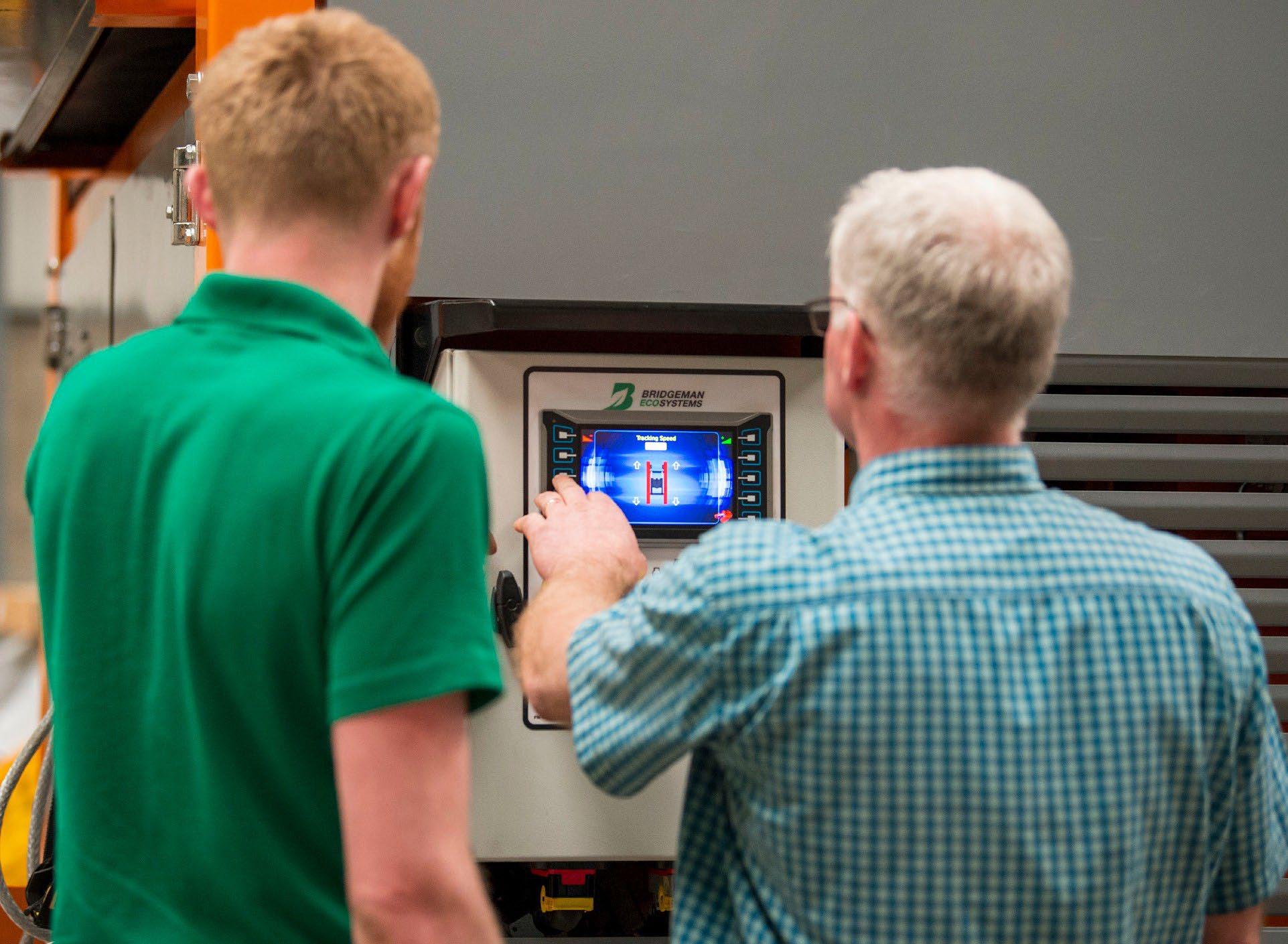
options were barriers to accessing supports, services, and recreational activities within the County. Accordingly, the objectives below aim to achieve the goal of making Meath a connected County with joined-up and accessible communities.
These objectives support the Key Principle of Economic Opportunity outlined in the RSES, including the RSO in relation to Improve Education Skills and Social
Inclusion (RSO 13). They also demonstrate consistency with RPOs including RPOs 4.16, 4.24 and 4.61 in relation to urban regeneration and improvements to educational attainment levels in areas of disadvantage.
Sustainable Community Objectives (SCO's) & Sustainable Economic Development Objectives (SEDO's)


SCO
To increase levels of local employment and conditions for employability


SCO
Increase opportunities for remote working

Continue to promote an economic and employment development ethos throughout SCO 7.3 all departments and functions within Meath County Council, including elected reps of the Council
To provide effective infrastructure provisionSEDO 7.4 sites and property solutions for employment generation

SEDO

To promote the economic opportunities and achievements in the County
OBJECTIVE SCO 7.1 To increase levels of local employment and conditions for employability
Action 7.1.1
Action 7.1.2
Action 7.1.3
Encourage increased levels of local employment through new and existing programmes LEO LCDC/LAG, Meath Partnership, Enterprise Ireland, IDA, LMETB
Increase awareness of funding supports and services available to persons in SME's and Employment.
Targeted needs analysis for migrants based in Meath to include migrant workers and their families; people seeking international protection and programme refugees also Ukrainian EU emergency directive refugees
Cultúr TBC: LEADER; LMETB; DEASP; Meath Travellers Workshop; Ukrainian Support Group
Action 7.1.4
Targeted response to the needs identified by the Migrant Needs Analysis in above action.
Action 7.1.5 Support the education of potential employers of migrants around employees rights, and assist in raising awareness of rights and responsibilities amongst potential employees, including immigrant workers
Action 7.1.6
CMC will use its networks to promote best employment practice and to raise awareness of best practice targeting both employers and employees. CMC will also provide employers with information on their statutory obligations.
Action 7.1.7 Forge mutually-beneficial linkages and partnerships with the business and third-level institutions including research and development facilities
Action 7.1.8 Assist enterprises in accessing a range of funding options so that the SMEs and indigenous industries can avail of grants and loans
DEASP IFA, Cultur, SICAP Programme Implementer, LCDC, LMETB
Short term, Ongoing (2024) Workshops / information sessions held
County Meath Chamber
Short term, Ongoing Literature developed and distributed; no. information sessions held
Planning and Economic Development Medium-long term, Ongoing Mutual presence on Boards of Management/committees together
Planning and Economic Development Short term, Ongoing (2024) No. funding applications submitted; No. successful funding applications
Action 7.1.9 Business Supports including training and mentoring programs, business development initiatives, and networking opportunities MCC Planning and Economic Development Short term, Ongoing (2024)
Action 7.1.10 Aid and support the collaborative working with education and training providers with relevant stakeholders and local employers to develop and deliver targeted responses to skills and employment needs
Planning and Economic Development
OBJECTIVE SCO 7.2 Increase opportunities for remote working
formal linkages between education/ training bodies and employers
Action 7.2.1 Support the continued development of hubs (commercial and community based) and create linkages with local enterprise / entrepreneurs / social enterprises in line with overall strategy
Action 7.2.2 Create a local hub group for Hub Managers to work together and collaborate.
Action 7.2.3 Explore opportunities for Digital and remote work hubs, in line with the National Remote Work Strategy: Making Remote Work.
Action 7.2.4 Support Remote workers by liaising with hubs to promote and deliver skills to advance funded training to these employees / hub users.
OBJECTIVE SCO 7.3 Continue to promote an economic and employment development ethos throughout all departments and functions within Meath County Council, including among elected reps of the Council
7.3.1
a marketing plan and initiatives aimed at promoting the Economic Development Strategy.
Action 7.3.2 Develop an updated County-level Economic Strategy.
Action 7.3.3 CMC will actively engage with business and industry to promote the expansion of existing employers and to attract new ones.
Planning and Economic Development
OBJECTIVE SEDO 7.4 To provide effective infrastructure provision – sites and property solutions for employment generation
Action 7.4.1 Promote our towns and strategic employment sites th i di f lt i Mth
Economic Dlt Uisce Eireann, NTA, TII
Action 7.4.2 Support creative placemaking and creative community projects and model as a vehicle for rural communities and economic regeneration.
and
creative employment opportunities.
creative placements as a model for community and economic development.
Action 7.4.5 Seek to promote the development of the 12 key strategic employment sites outlined in the Meath CDP for employment generation in Meath
Meath Arts Office, MCC Planning and Economic Development–Heritage and Conservation Officers LMETB, LEO, Meath Partnership, MCC, MCC Economic Development, Boyne Valley Tourism, MCC Culture Team
Ongoing (2024)
Utilise existing employment zoned land in suitable location for industry and enterprise use.
7.4.7 Facilitate collaboration to support the development of the Dublin - Belfast Economic Corridor, to drive synergy in the Drogheda-Dundalk-Newry cross border network and strengthen economic links with the south east extending to Rosslare Europort.
7.4.8 Develop the Metropolitan towns of Dunboyne, Maynooth and Kilcock to ensure a steady supply of serviced development lands to support sustainable growth.
8.1 Who will monitor and review the implementation and progress of the LECP?
Monitoring of these Implementation Plans will be undertaken regularly by an independent working group of local enterprise, innovation and community stakeholders.
8.2 How often will the LECP be reviewed?
The LECP will be delivered through a series of Annual Implementation Plans agreed at the start of each year to achieve the targets set out. Monitoring of these Implementation Plans will be undertaken on an ongoing basis, with an annual report prepared and submitted to the Meath LCDC.
Two interim reviews will be undertaken to further monitor progress and align relevant objectives and actions to evolving needs. These interim reviews will take place in 2025 and 2027.
8.3 How is the LECP evaluated?
The LECP includes High-Level Goals, each with several related objectives and actions. Each objective includes one or more success indicators to measure progress toward the achievement of the High-Level Goal (see the action tables above).
These will undergo ongoing monitoring based on the prioritisation of actions and the determination of outputs and indicators for each Implementation Plan.
In order to support comprehensive evaluation of LECP interventions the development of case studies will also form part of the monitoring process for the LECPs. To support a consistent approach to these case studies the case study template used for the Social Inclusion and Community Activation Programme (SICAP) programme will be used as a template to use for LECP case studies.
A final review and support for the development of the subsequent round of LECPs will be informed by both the quantitative and qualitative data collected as part of the Implementation Plan and ongoing monitoring process.
8.4 Can the public access the monitoring and evaluation process?
The annual implementation reports will be published yearly, and the interim reports will be published every two years.
9.1.1 Economic National Policies & Plans
Employment
Pathways to Work Strategy 2021 – 2025
National Further Education and Training Strategy 2020 –2024
Building Future Skills: The Demand for Skills in Ireland’s Built Environment Sector to 2030
Development
Housing for All: A New Housing Plan for Ireland
Project Ireland 2040
Town Centre First Policy
National Development Plan 2018 - 2027
National Planning Framework
Rural Development Policy 20212025 – Our Rural Future Connectivity
Transport Infrastructure Ireland
Connecting Ireland Rural Mobility Plan: Enhancing Public Transport Across Rural Ireland
National Broadband Plan
Putting People First: Action
Programme for Effective Local Government
Economy and Enterprise
National Economic Plan (NEP)
National Recovery and Resilience Plan
People, Place and PolicyGrowing Tourism to 2025
Enterprise 2025 RenewedBuilding resilience in the face of global challenges
National Social Enterprise Policy for Ireland 2019-2022
Report of the SME Taskforce: National SME and Entrepreneurship Growth Plan
Sustainability
Sustainable Development Goals National Implementation Plan 20182020
Waste Action Plan for a Circular Economy
Regional and County Policies and Strategies
Regional Spatial and Economic Strategy (RSES) for EMRA
Regional Enterprise Plan to 2024Mid- East
Meath Economic Development Strategy
Local LEADER Development Strategy- Meath
Meath County Development Plan 2019-2025
Transport Strategy for the town of Drogheda and Vicinity
Transport Strategy for the Greater Dublin area 2022-2042
National Policies and Plans
Sustainable, Inclusive and Empowered Communities: A Five-Year Strategy to Support the Community and Voluntary Sector in Ireland 2019-2024
National Policy Statement the Bioeconomy CAP Strategic Plan 2023 - 2027
Rural Development Policy 2021-2025 - Our Rural Future
Housing for all: A New Housing Plan for Ireland
Housing Options for Our Aging Population Policy Statement 2020
Town Centre First Policy
Climate Change Sectoral Adaptation Plan
Youth Justice Strategy 2021 - 2027
National Action Plan for Equity of Access to Higher Education 2015- 2021
Programme for Government: Our Shared Future
Civil Defence - Towards 2030
Making Remote Work: National Remote Work Strategy
IDA Ireland: Driving Recovery and Sustainable Growth 2021 –2024
Sustainable Development Goals National Implementation Plan 20182020
International Financial Services Strategy
Ireland’s Diaspora Strategy 2020- 2025
Sláintecare Implementation Strategy and Action Plan 20212023
Healthy Ireland Framework 2019- 2025
Roadmap for Social Inclusion 2020 - 2025
National Positive Aging Strategy (NPAS)
National Dementia Strategy
National Carers Strategy
Putting People First: Action Programme for Effective Local Government
20-Year Strategy for the Irish Language 2010–2030
National Traveller and Roma Inclusion Strategy 2017 - 2021
National Migrant Integration Strategy
National Disability Inclusion Strategy (2017-2021)
LGBTI+ Inclusion Strategy 2019-2021
National Plan Against Racism
Third National Strategy on Domestic,
Sexual and Gender-based Violence
Regional and County Policies and Strategies
Midlands Louth Meath CHO Healthy Ireland Implementation Plan 2018 –2022
Healthy Meath Plan 2019-2021
Louth & Meath Integrated Migrant Strategy 2019-2022
Meath Traveller Accommodation Programme 2019-2024
Meath Joint Policing Committee Strategic Plan 2021-2026
Meath Children and Young People’s Services Committee Children and Young People’s Plan 2018- 2020
Meath Climate Action Strategy 2019 – 2024
County Meath Biodiversity Action Plan 2015-2020
Meath County Culture and Creativity Strategy
Planning, Economic Development, Enterprise and European Affairs SPC
Elected Representatives
• Councillor Stephen McKee
• Councillor Joe Fox
• Councillor Brian Fitzgerald
• Councillor Padraig Fitzsimons
• Councillor Aishling Dempsey
• Councillor Tommy Reilly
• Councillor Helen Meyer
• Councillor Sarah Reilly
• Councillor Elaine McGinty
• Councillor Alan Tobin
Sectoral Representatives
Environment/ Conservation:
• Awaiting replacement nomination
Agriculture/Farming Sector:
• Fergal Hennessy
Business /Commercial:
• Sean Boyle
Development/Construction:
• Gary Plunkett
Statutory Sector
• Fiona Lawless - Chief Executive, Meath County Council
• Cllr Yemi Adenuga - Meath County Council
• Cllr Elaine McGinty - Meath County Council
• Cllr Mike Bray - Meath County Council
• Sharon Curran - Department of Social Protection
• Sadie Ward McDermott - Louth/Meath Education & Training Board
• Lorraine Flynn - Health Service Executive
• Sean O'Coisdealbha - Údaras na Gaeltactha
• Joe English - Local Enterprise Office
Non-Statutory Sector
• Colin Ludlow - Meath Partnership
• Garret O’Brien - Community Sector
• Community Sector - Vacant
• Susuana Komolafe - Social Inclusion
• Shola Yahya - Social Inclusion
• Ciara Burke - Chambers of Commerce
• Suzanne Brady - Environmental Sector
• Seamus McGee - Farming Sector
• Noel Maguire - Trade Union Sector
• Geraldine Hogarty - Youth Work Ireland LCDC Chief Officer
• Ms Fiona Fallon, Meath County Council
Consultation submission details
Meath Public Participation Network Submission from Social Inclusion Pillar of Meath PPN
• LECP strategic opportunity and risks
• Implementation, interagency planning, resource coordination
• Independent monitoring and evaluation
• County Social Inclusion Strategy
• Feedback informed recommendation to undertake independent monitoring and evaluation of LECP.
• Feedback informed SCOs within High-Level
• Goal 5: A County that works together.
• Feedback informed SCO and associated actions within High-Level Goal 3: A County that welcomes, empowers and includes all communities. 2
Local Link Louth Meath Fingal Submission by Local Link Louth Meath Fingal to Meath County Council for the Local Economic and Community Plan 2023-2029
• Increasing the efficacy of public transport options to ensure connectivity and access
• Feedback informed the addition of transport as a standalone High-Level Goal.
• Feedback informed priority areas and actions within Goal 7: A connected County accessible to all 3 Patrick Finn Sensor Lights
Jack Holmes Meath Local Economic and Community Plan 20232029 Submission
• Increase the attraction of living in, working in, and visiting Ashbourne
• Feedback informed the addition of transport as a standalone High-Level Goal. 5 Swim Ireland
• Include swimming as a component of health and wellbeing by providing infrastructure and strategic support to increase swimming opportunities in the County
